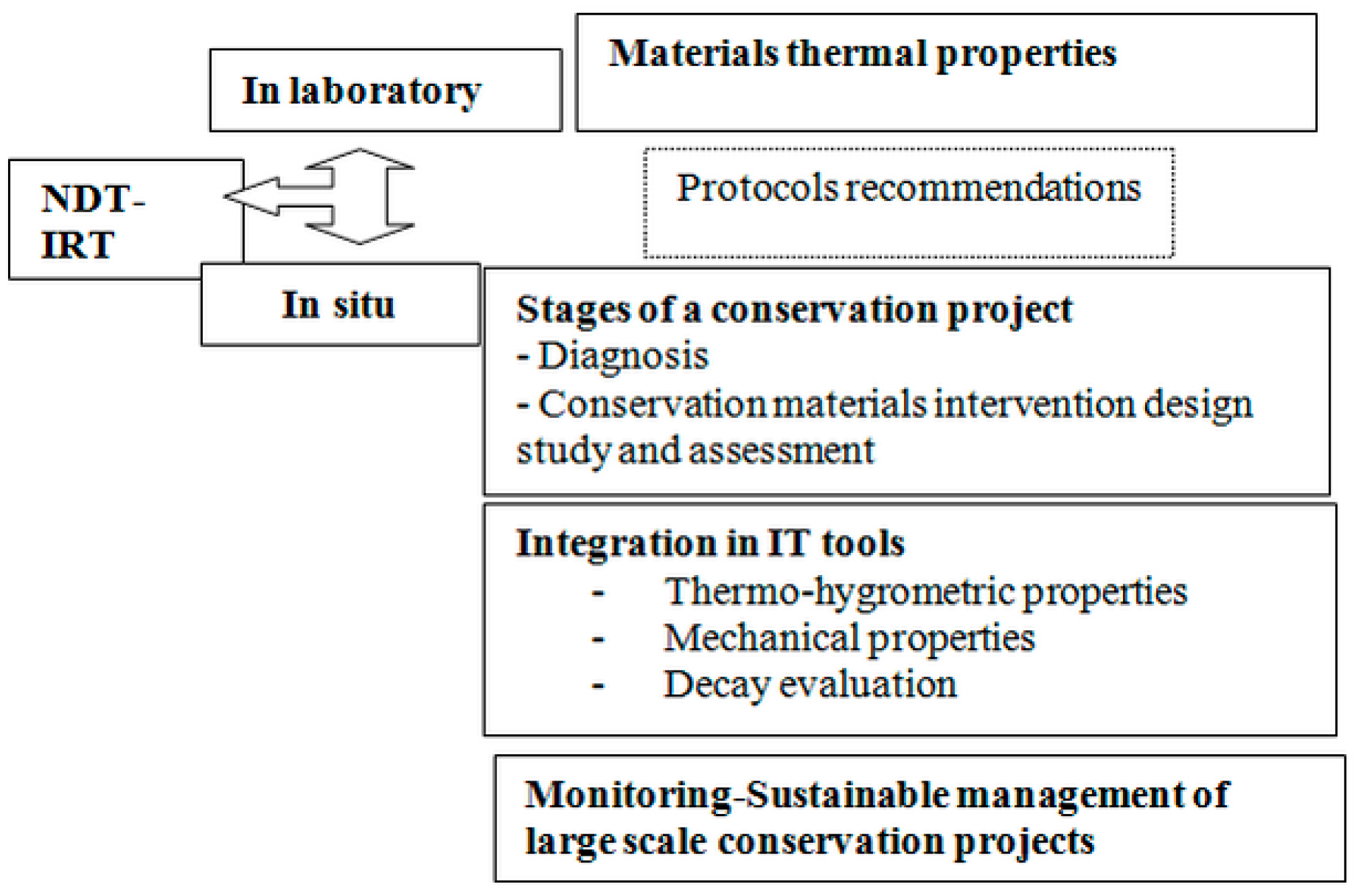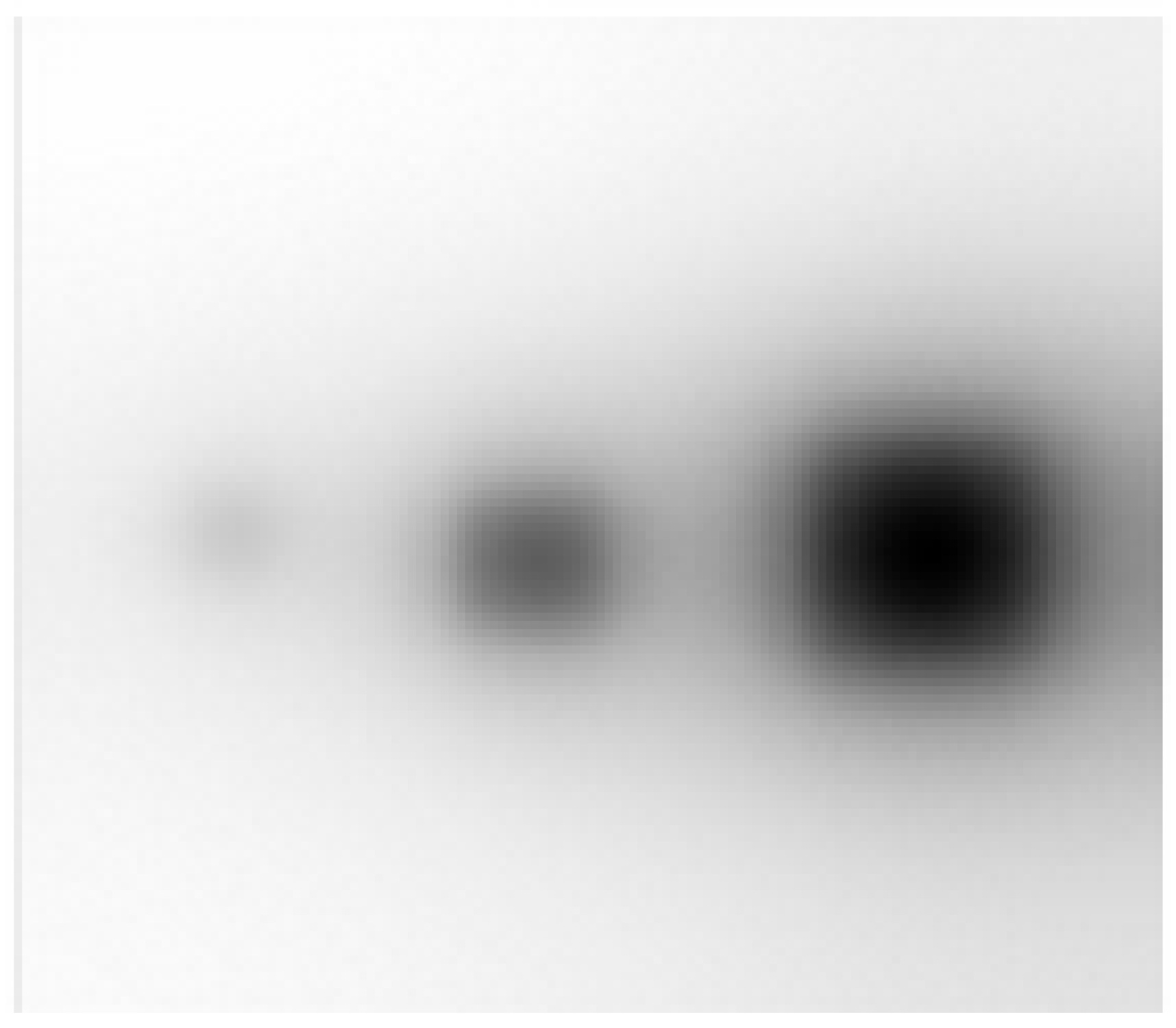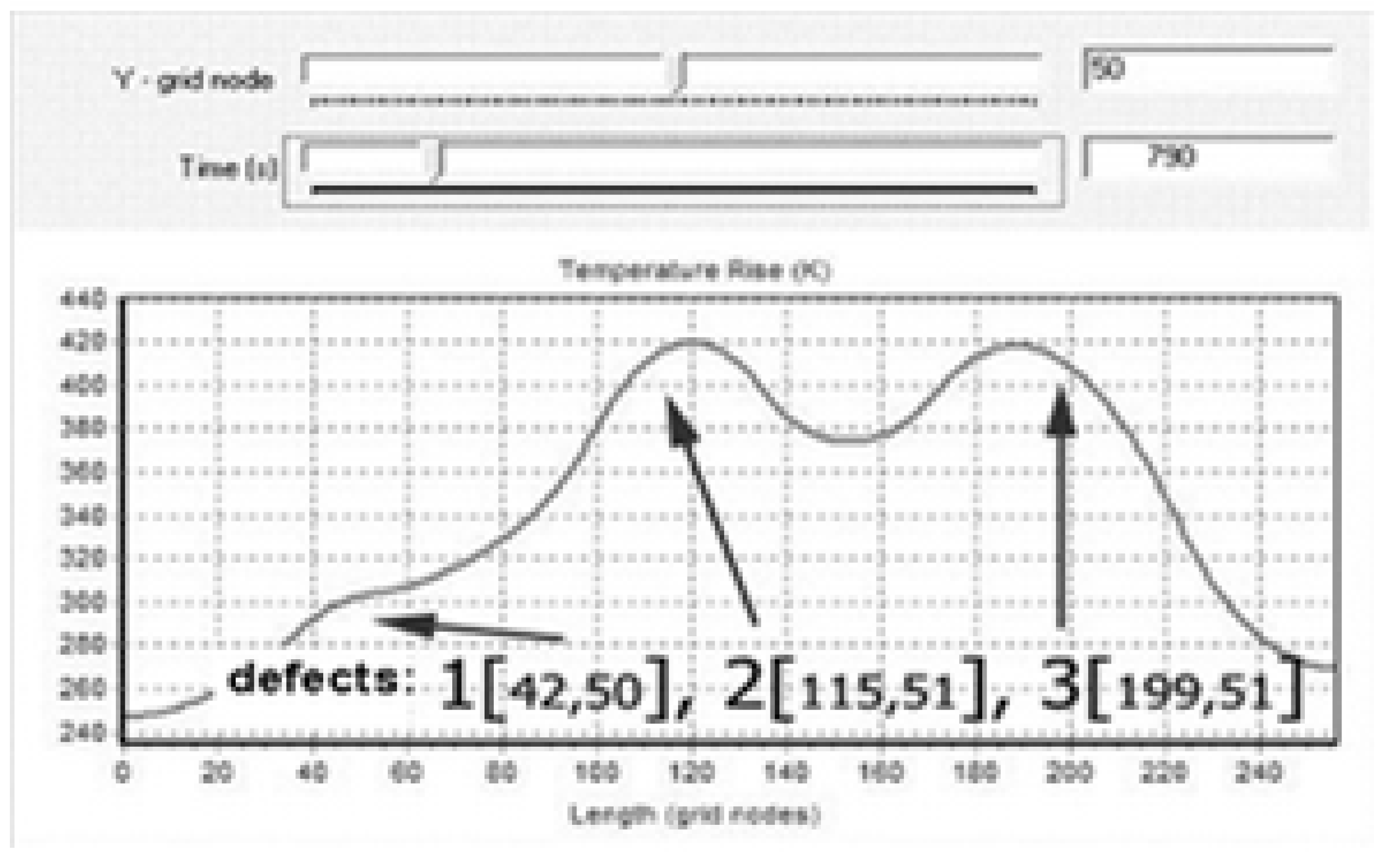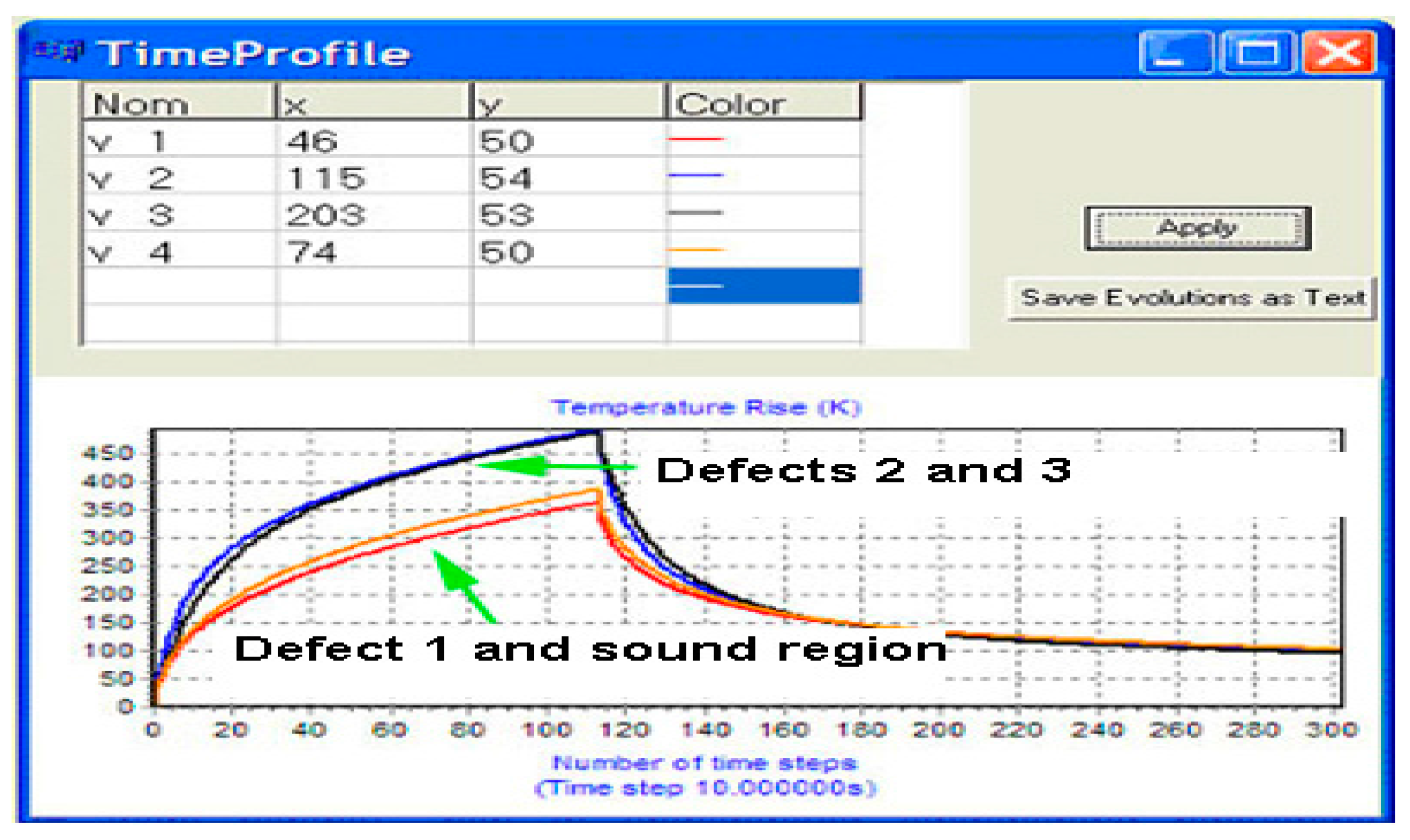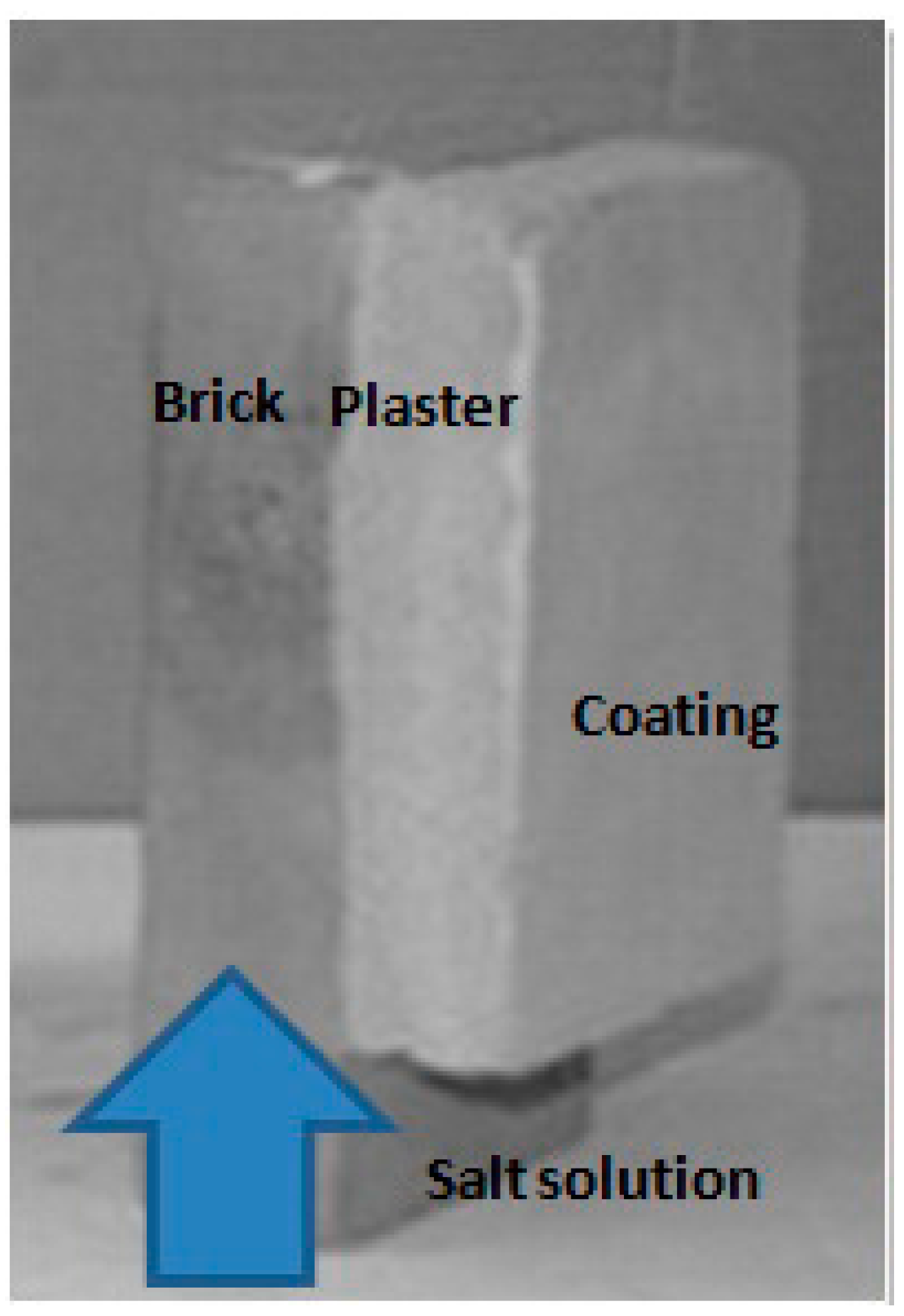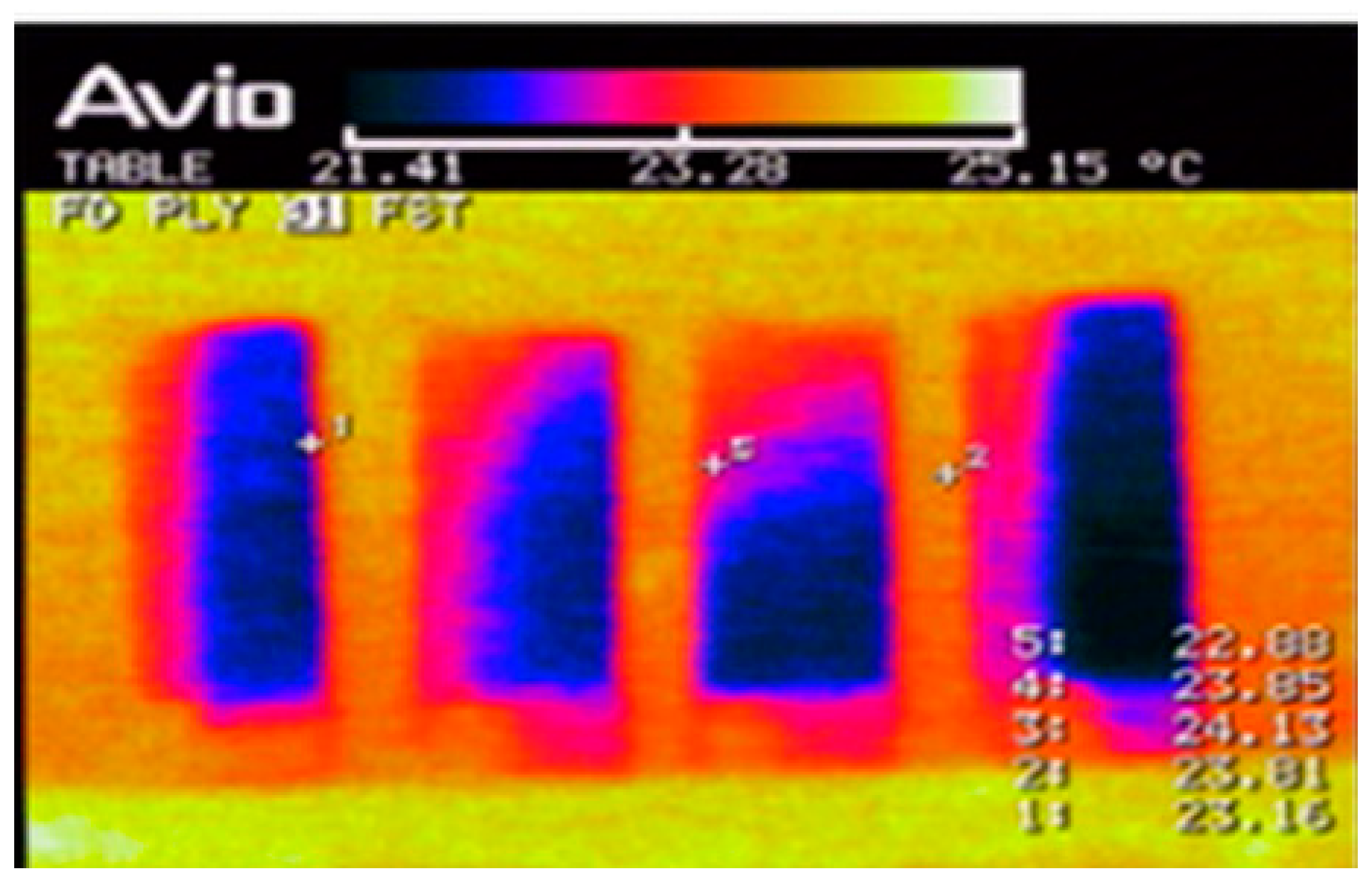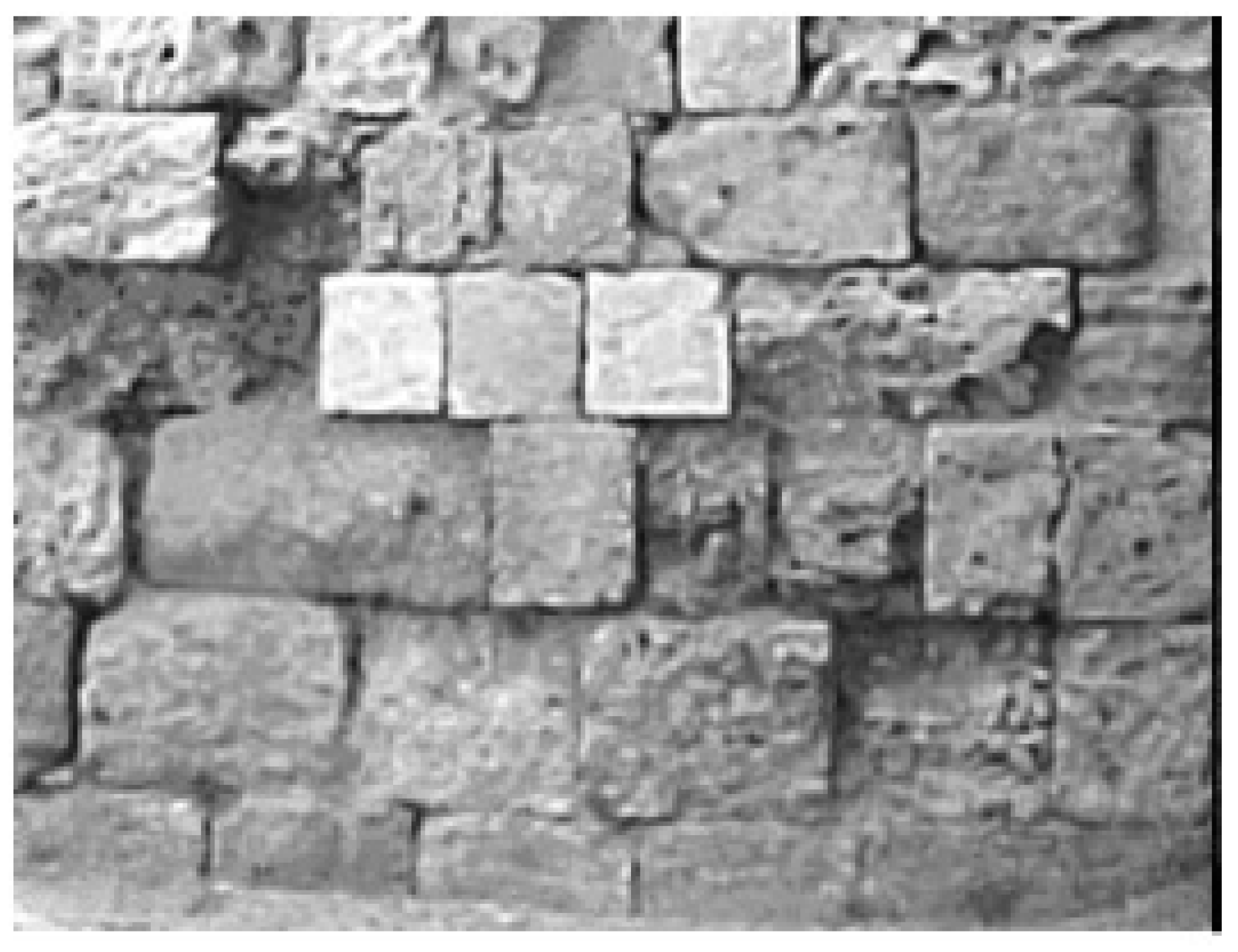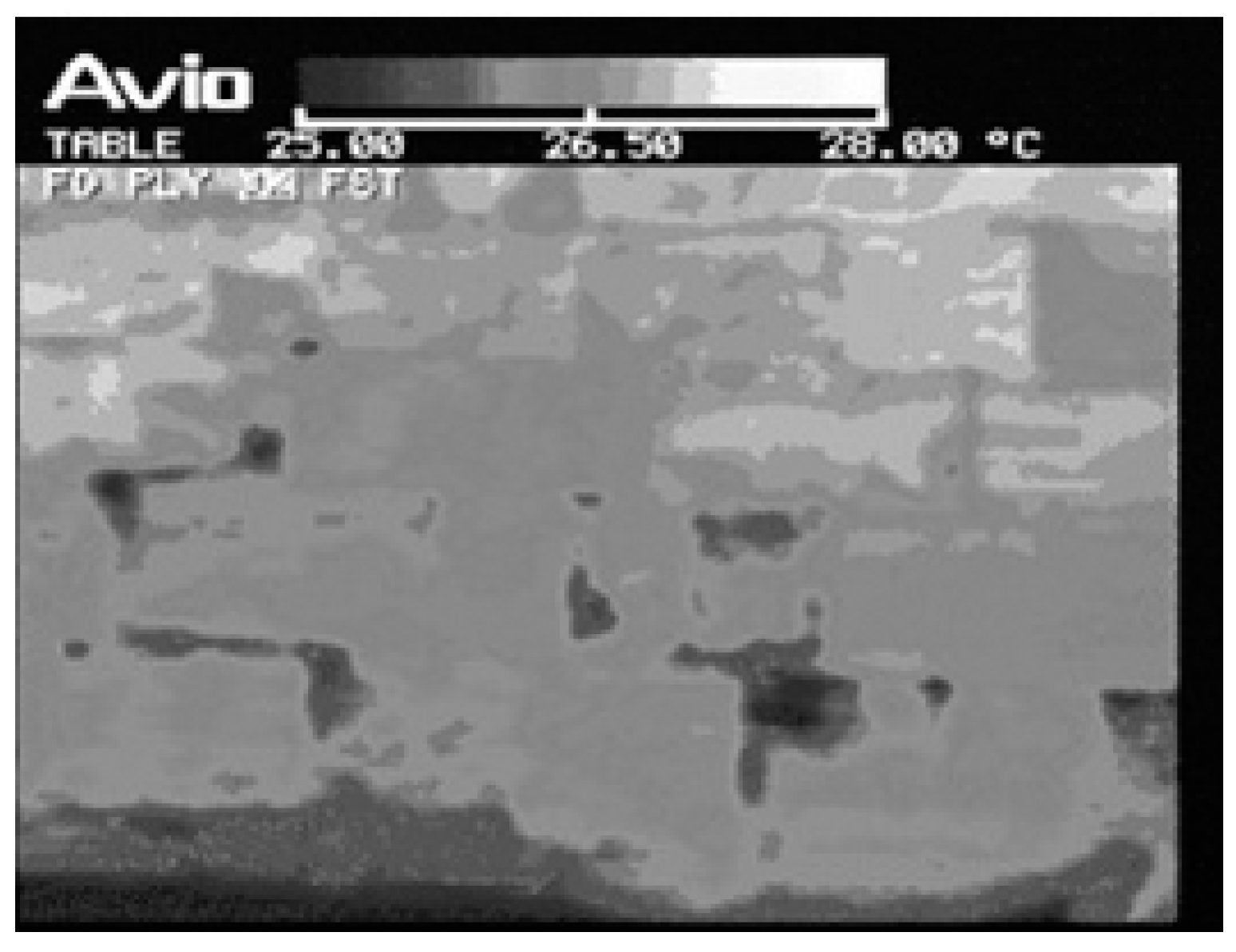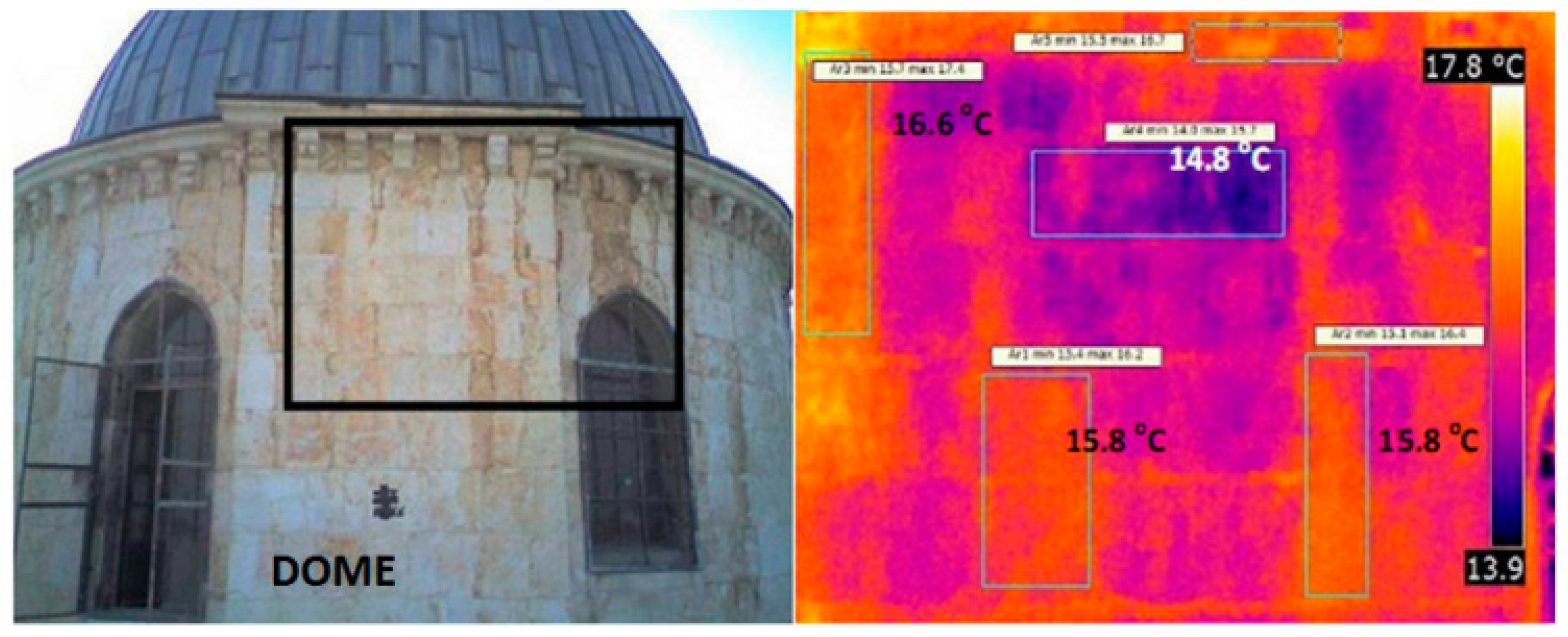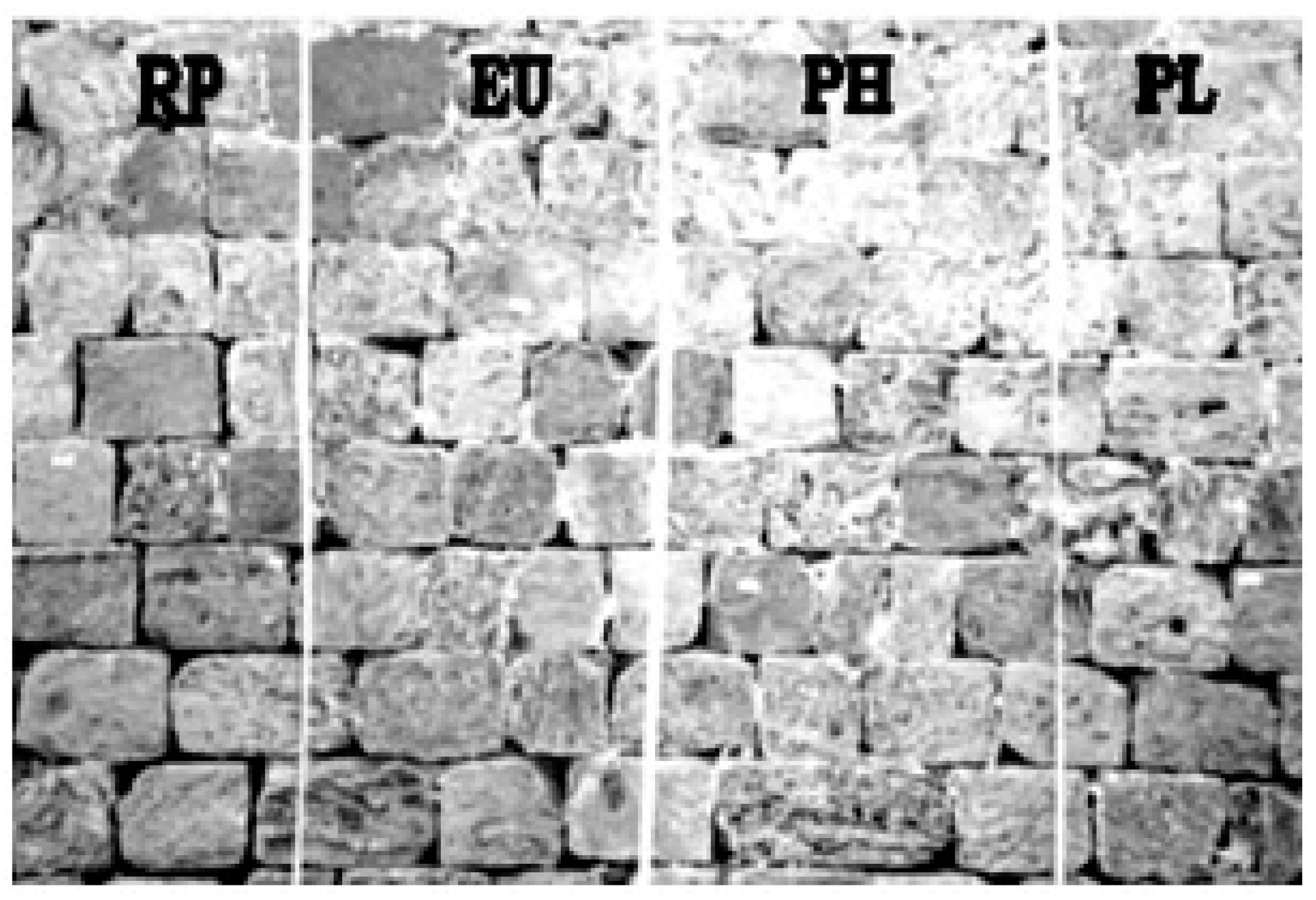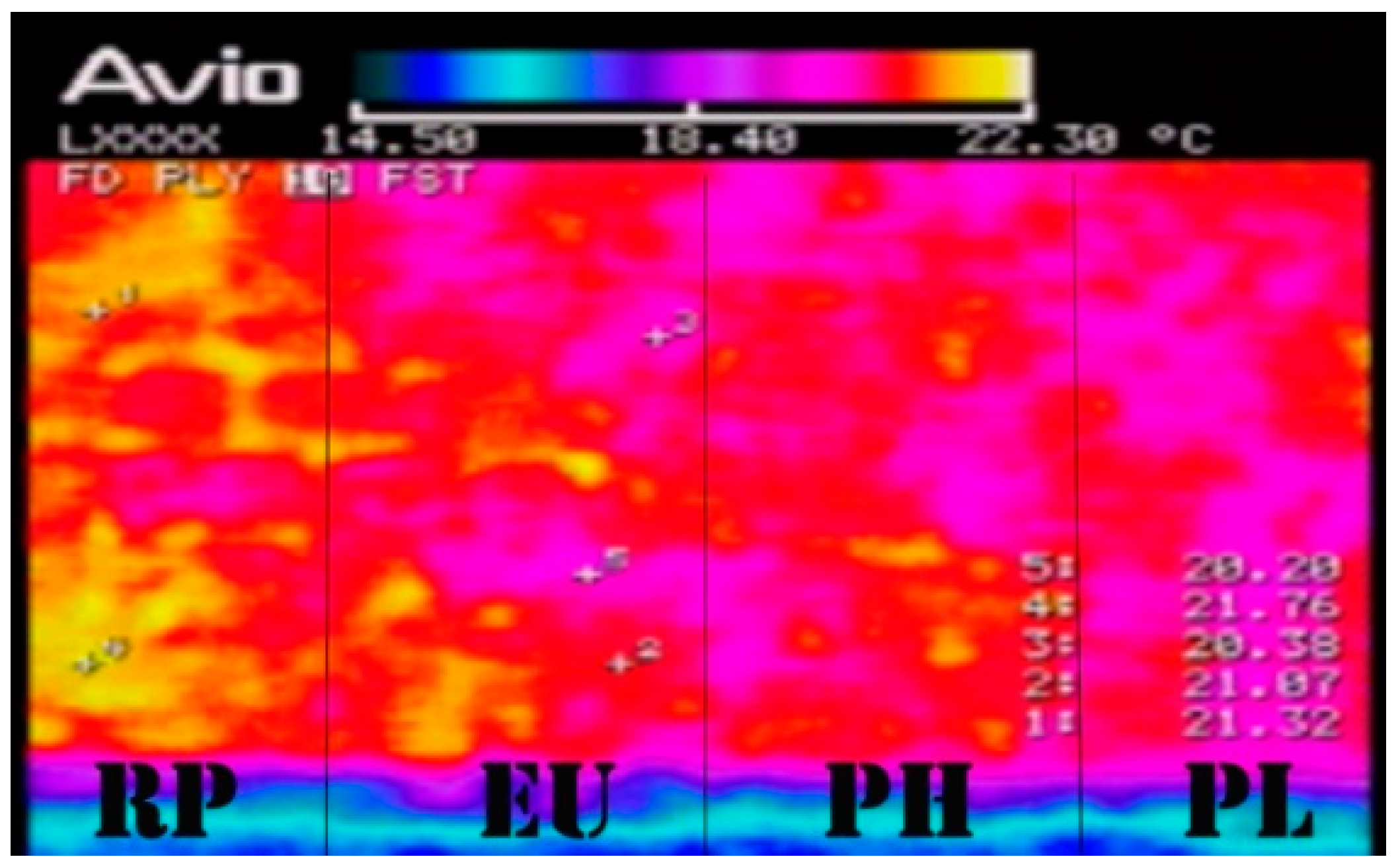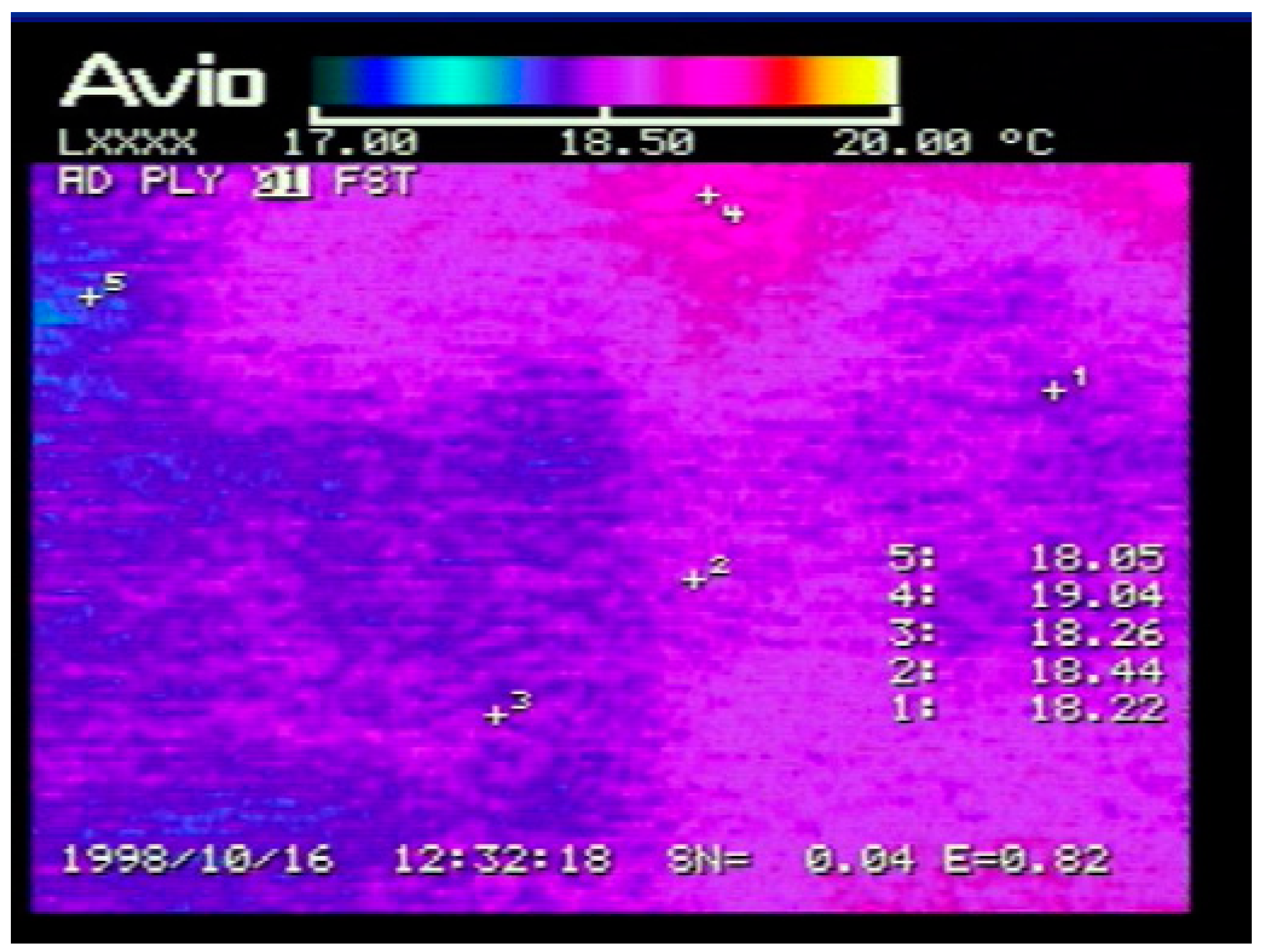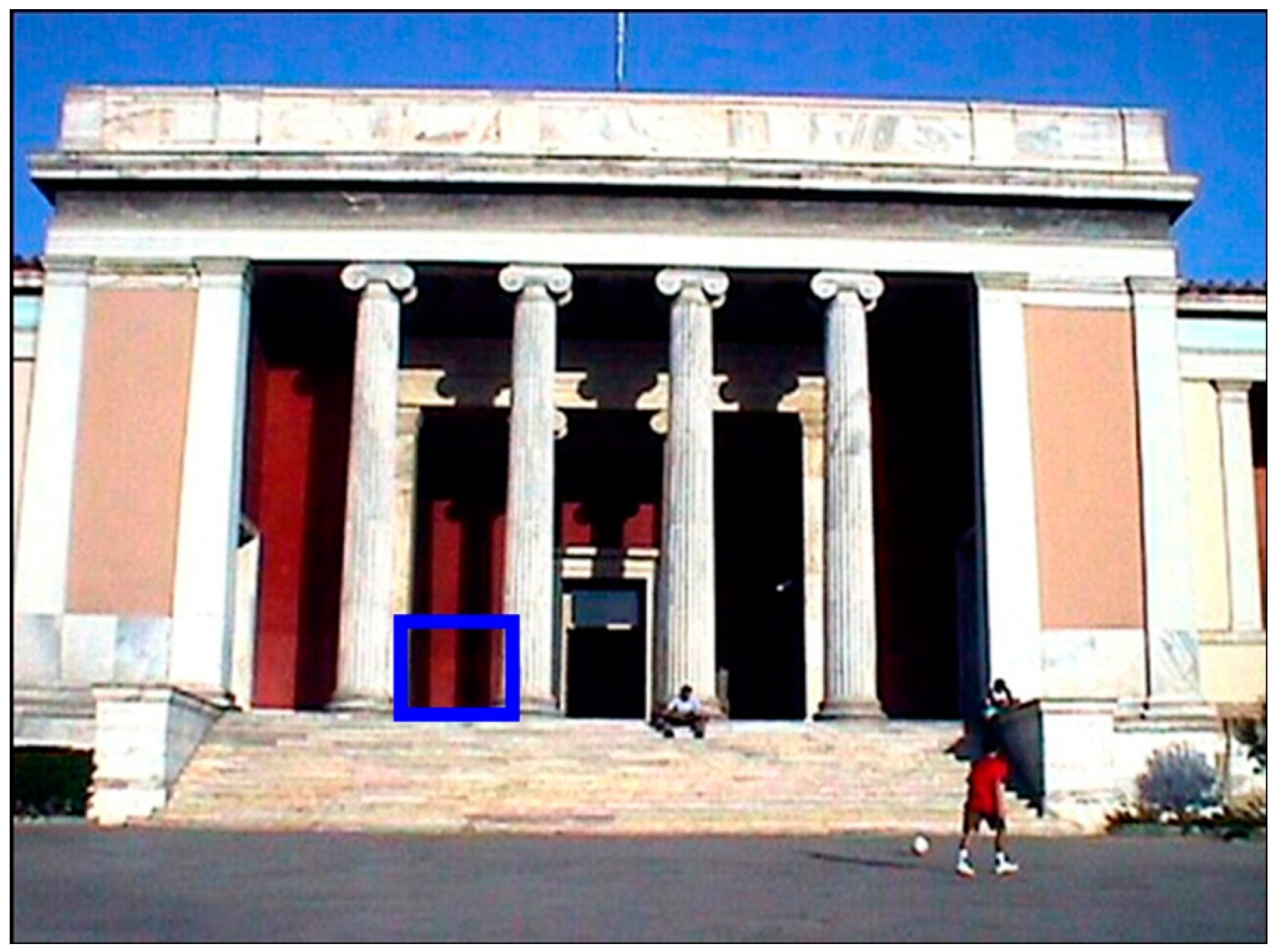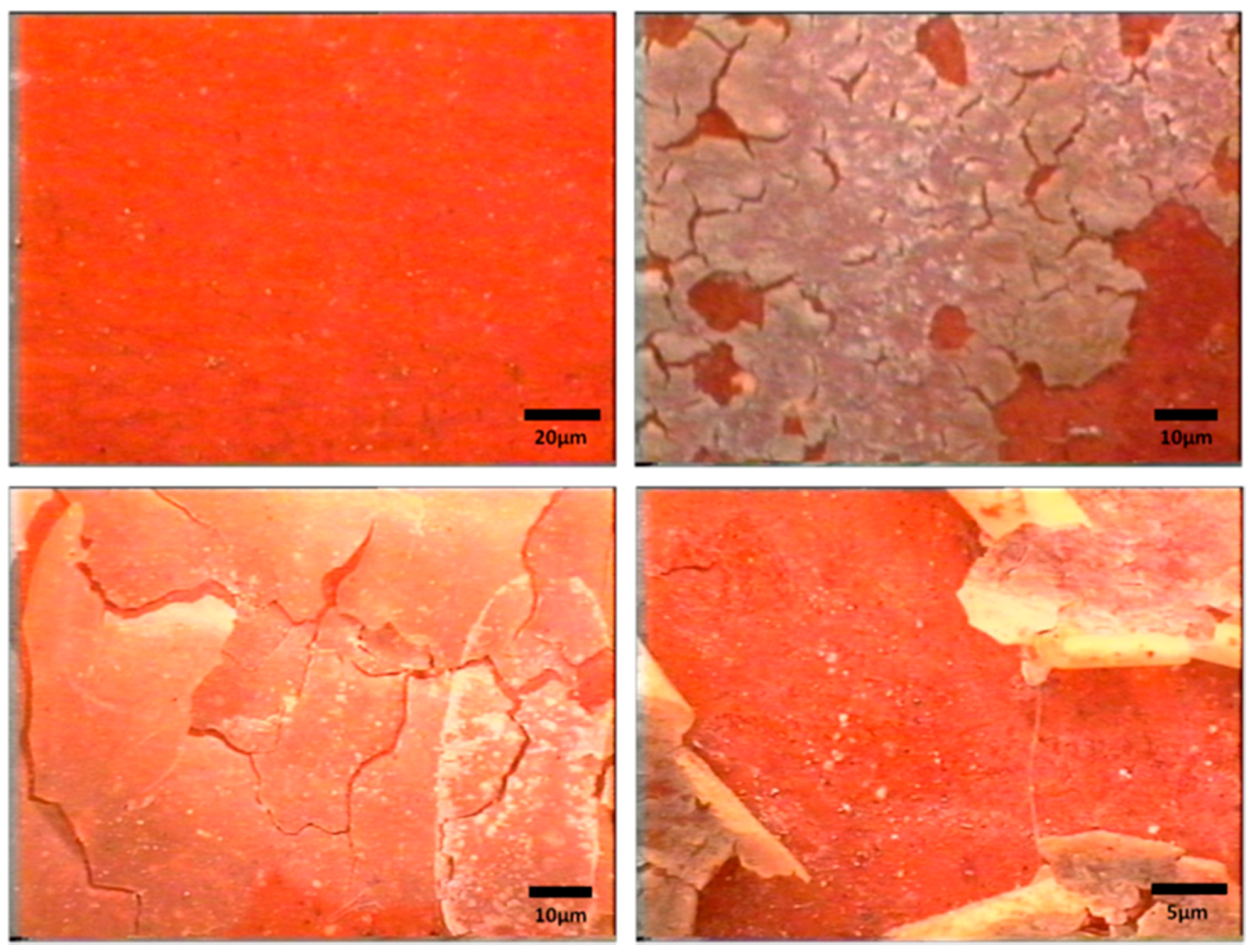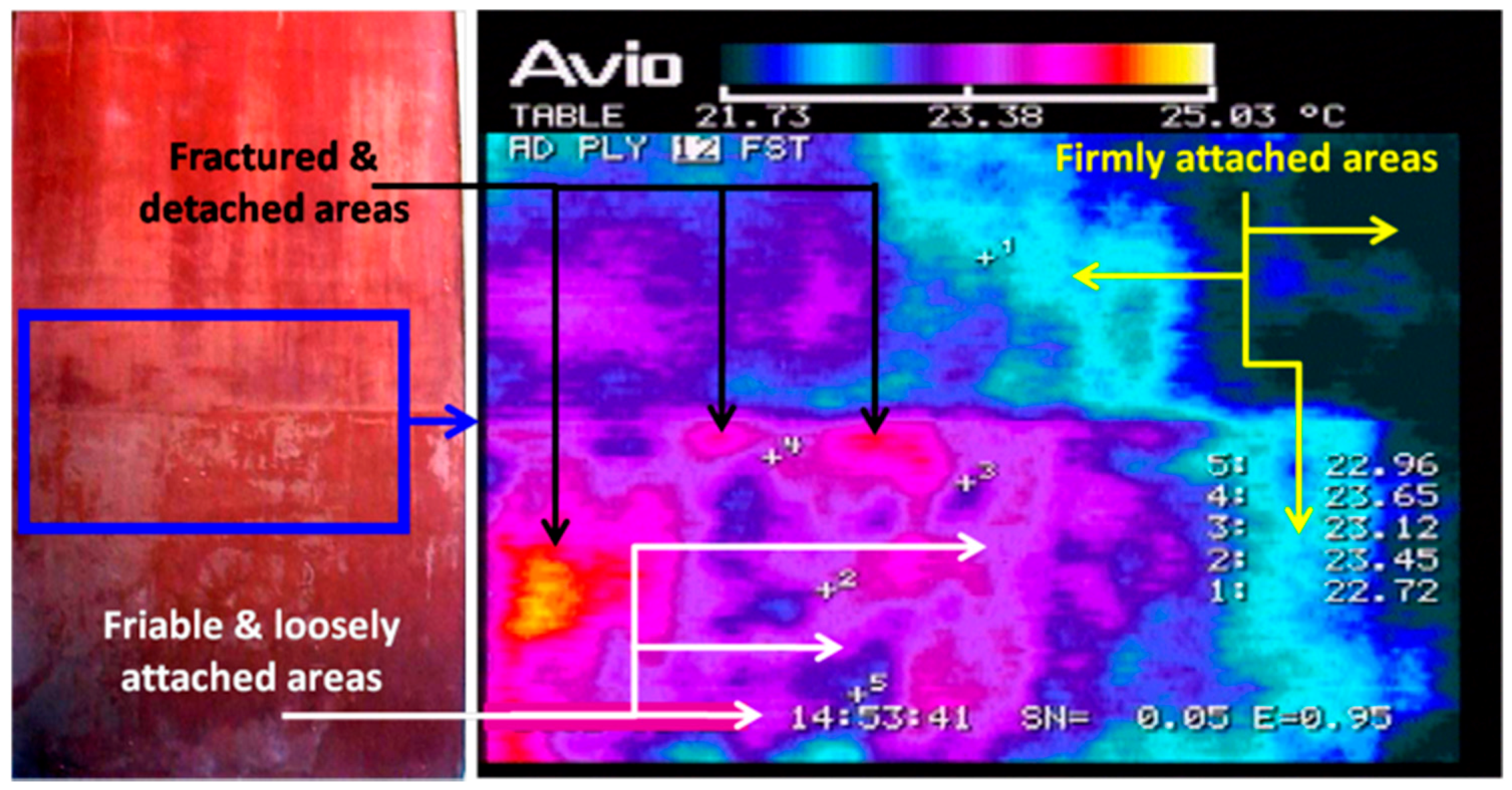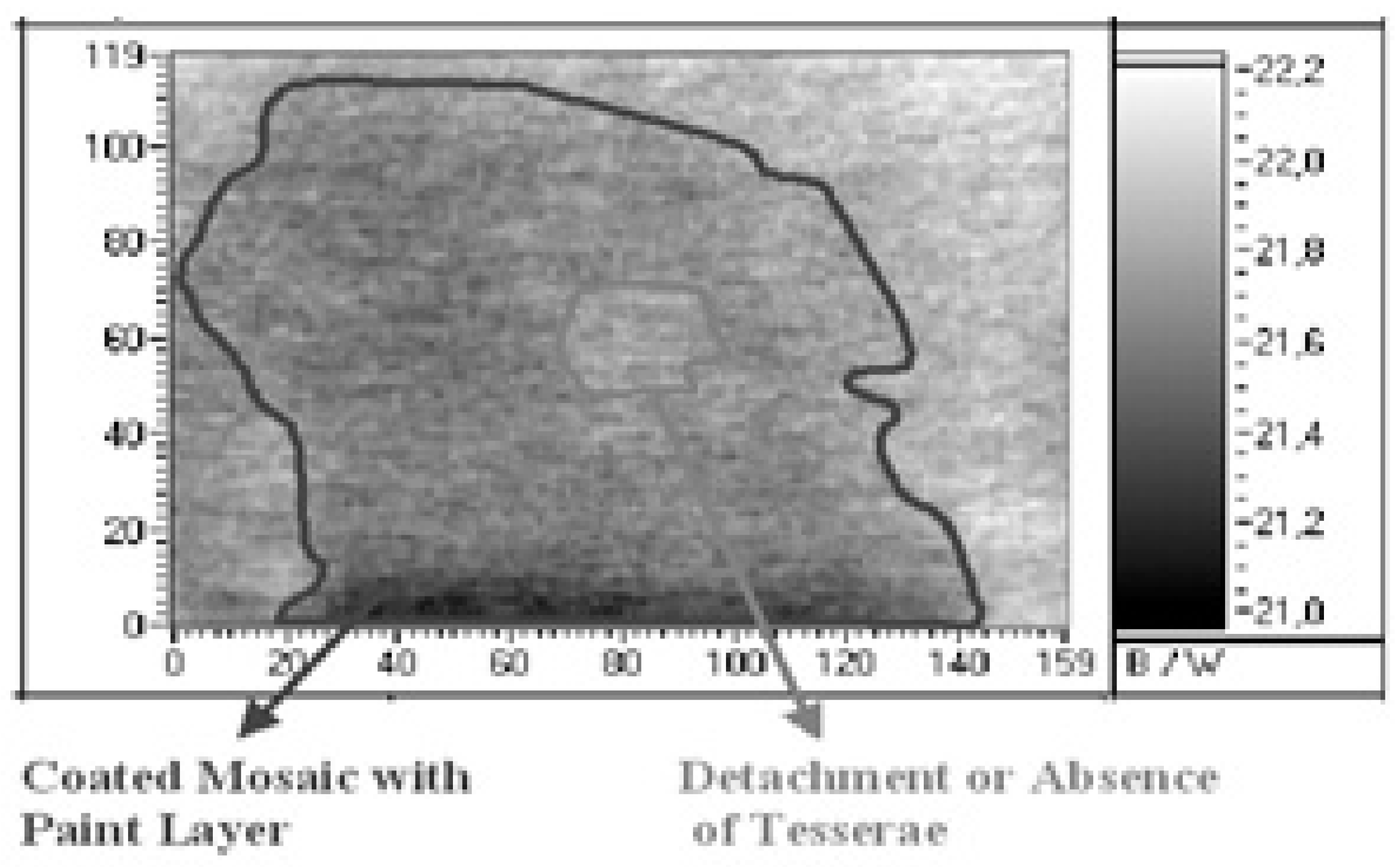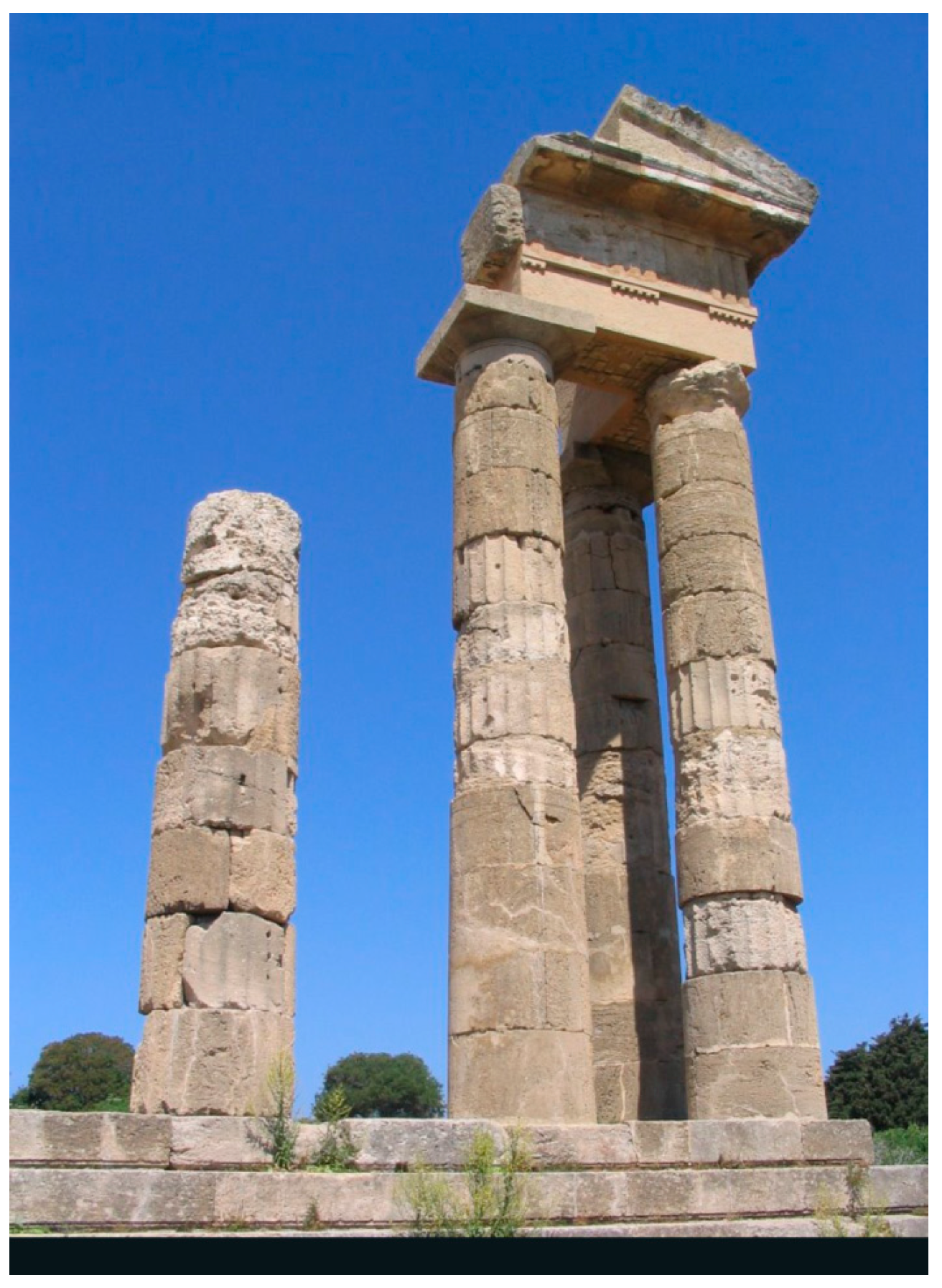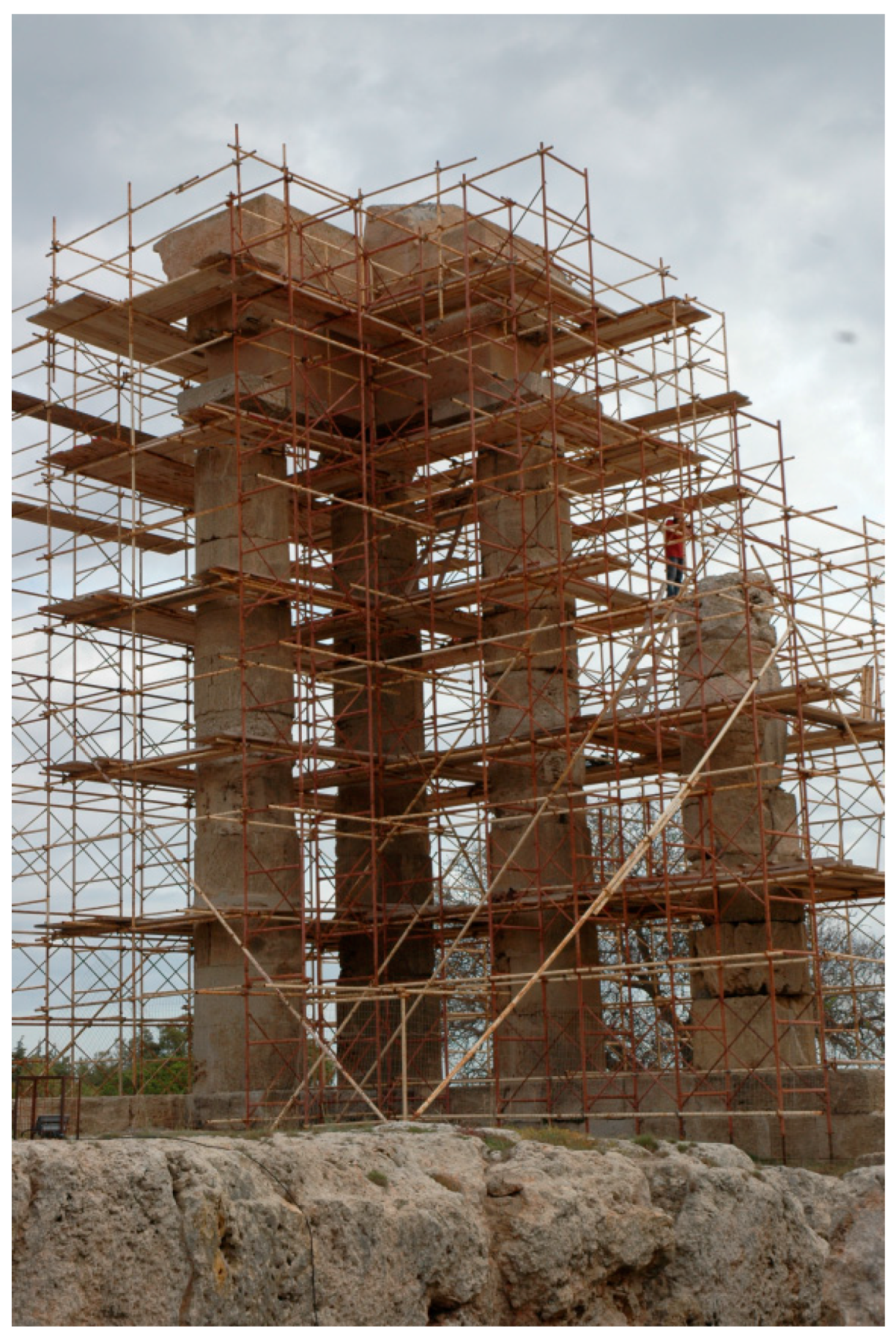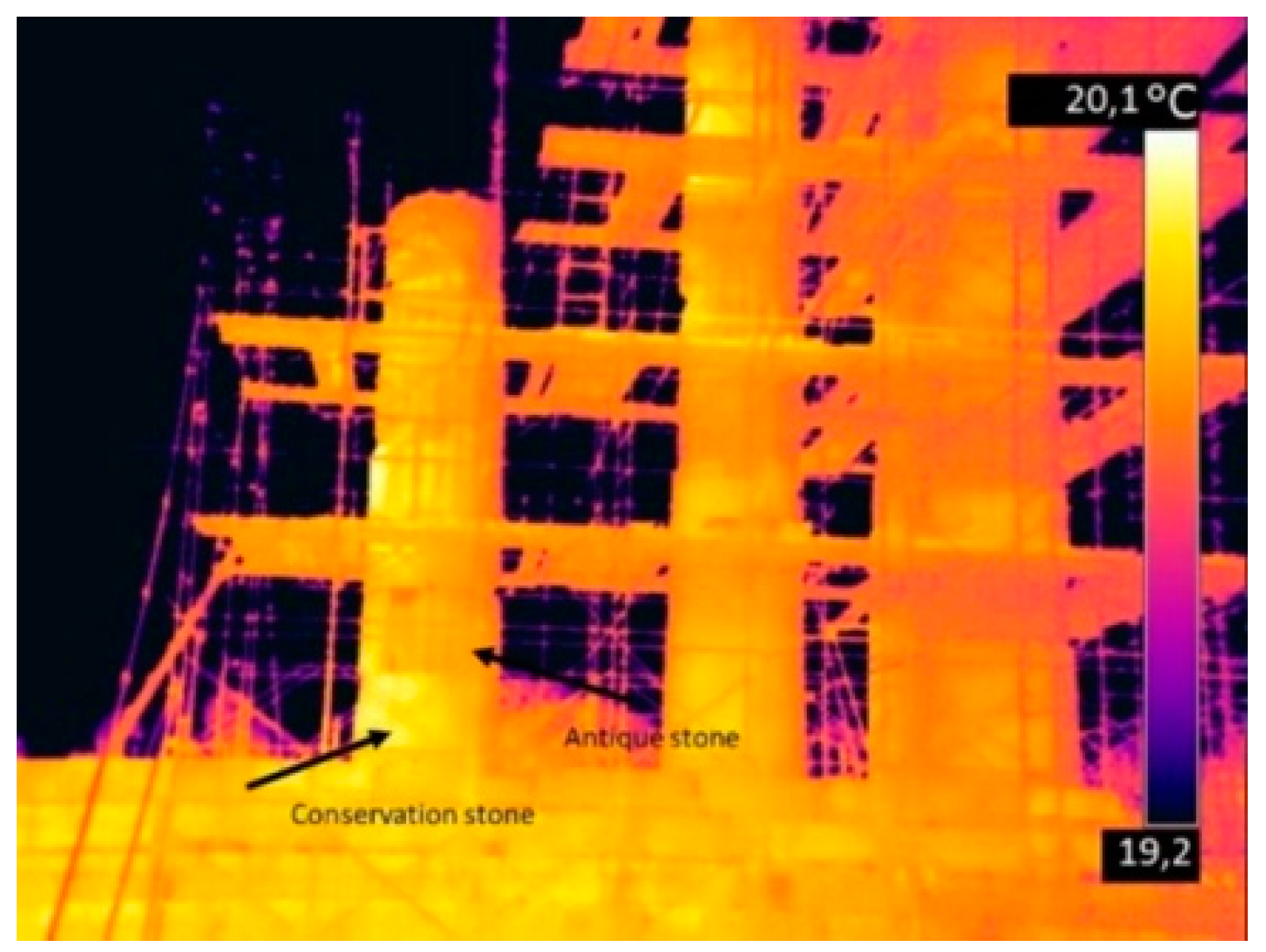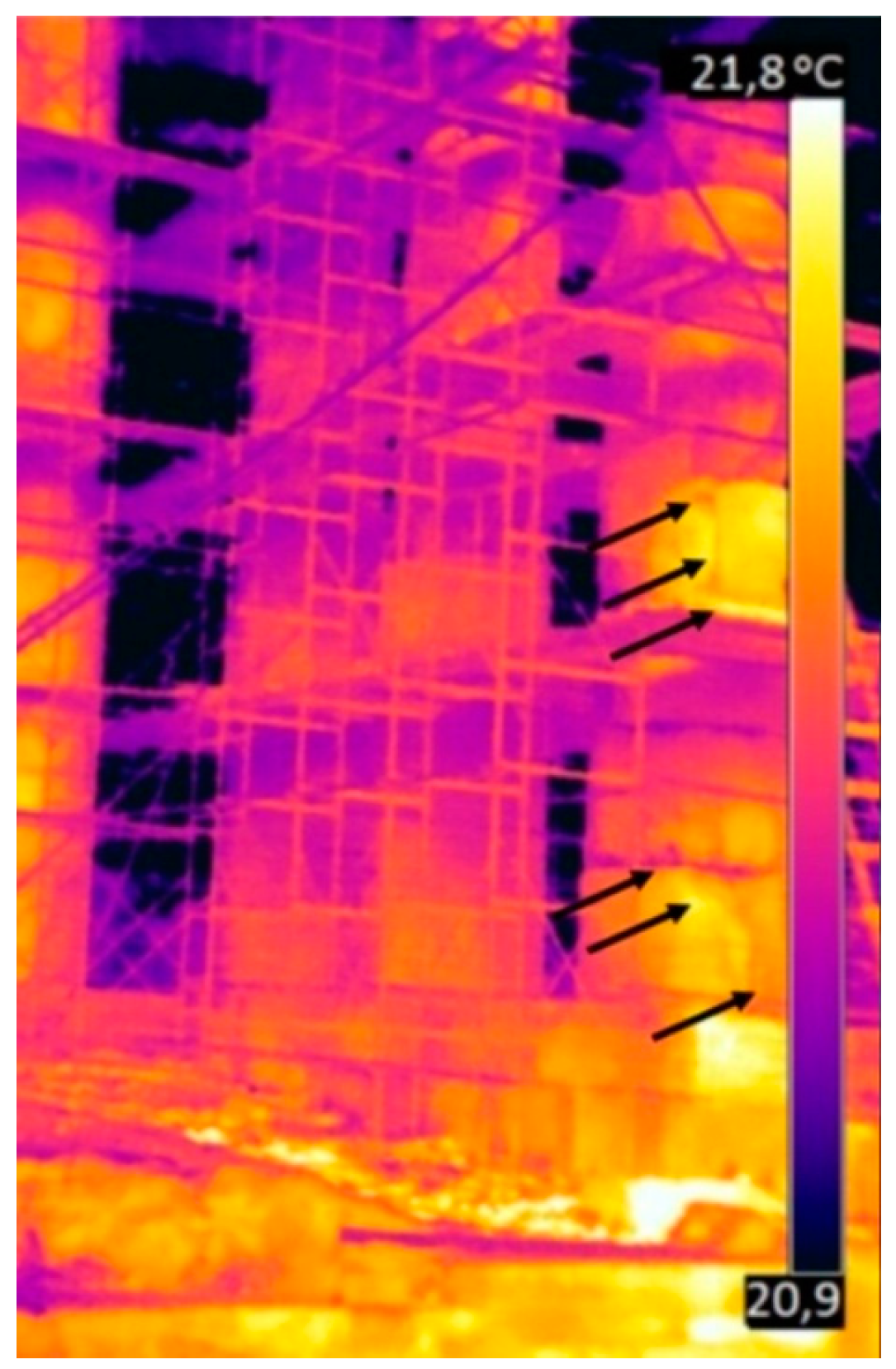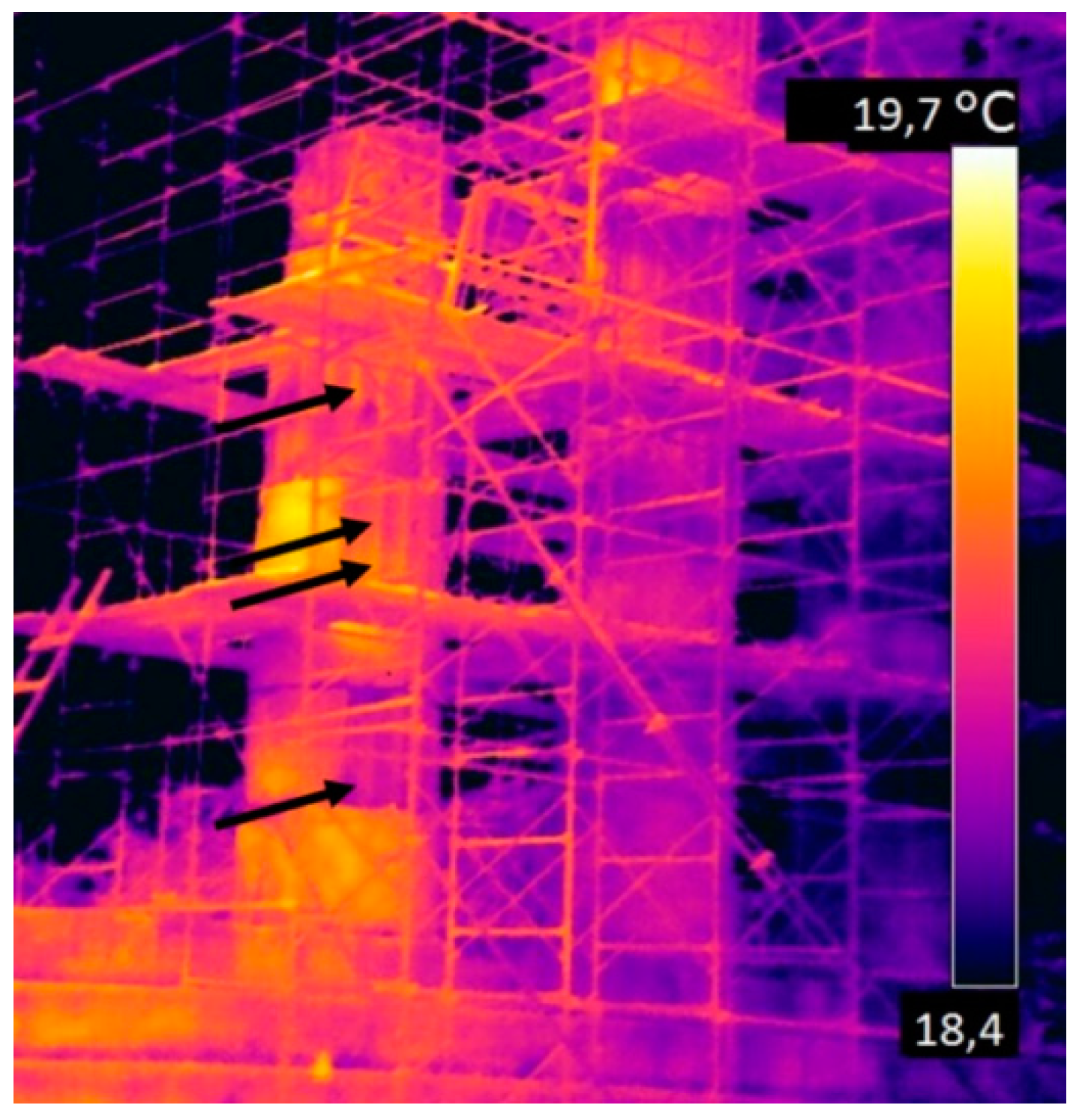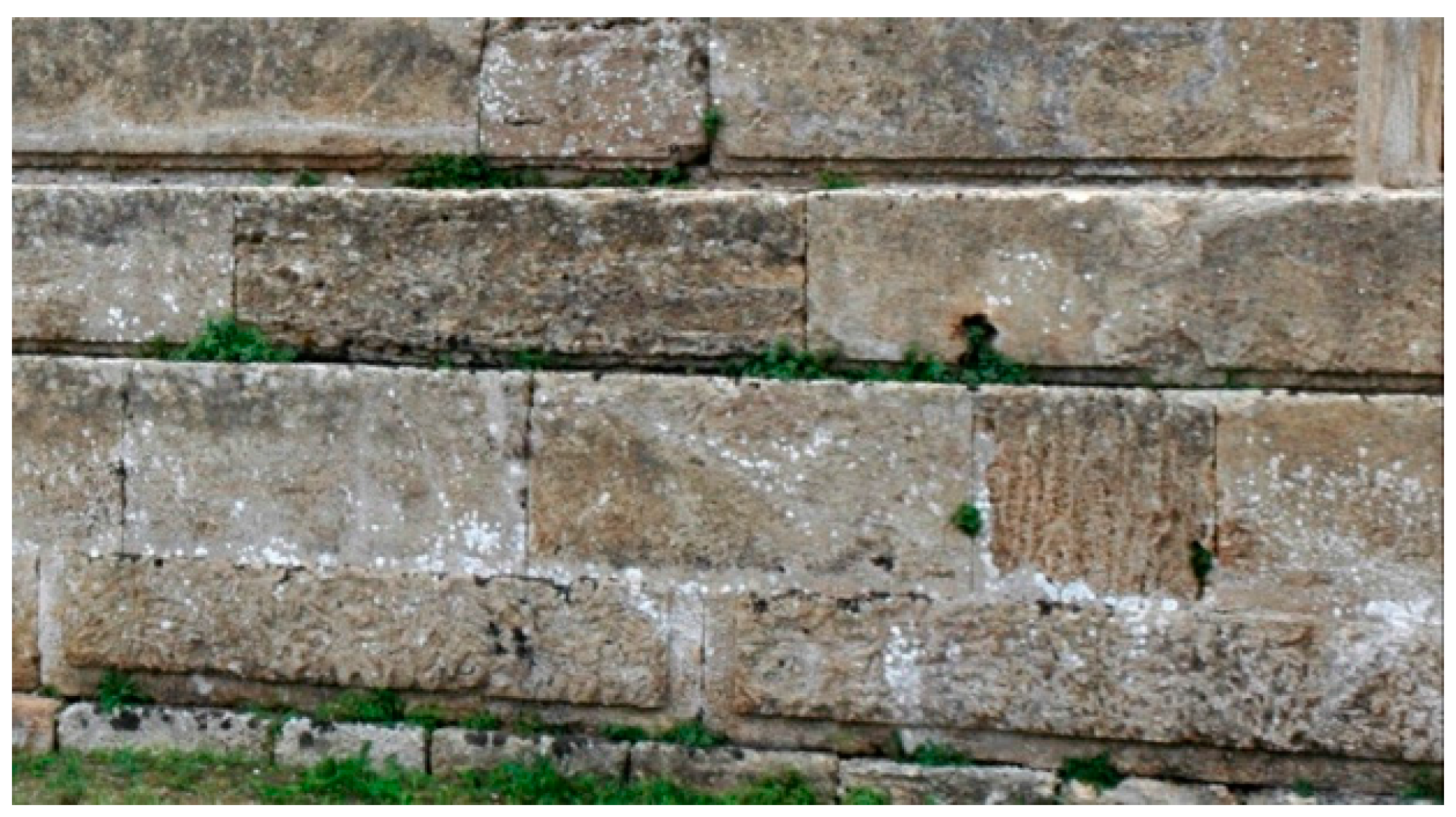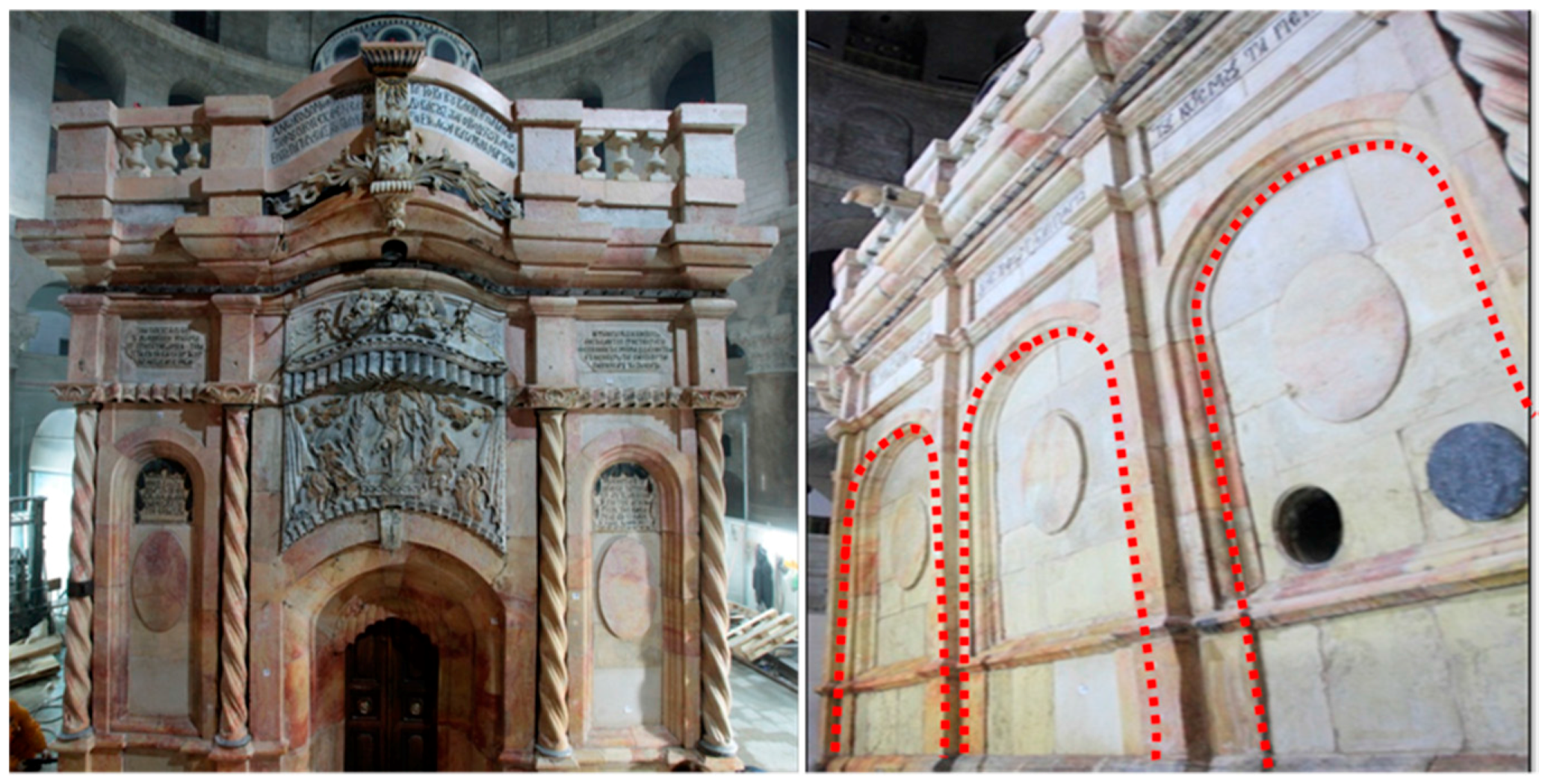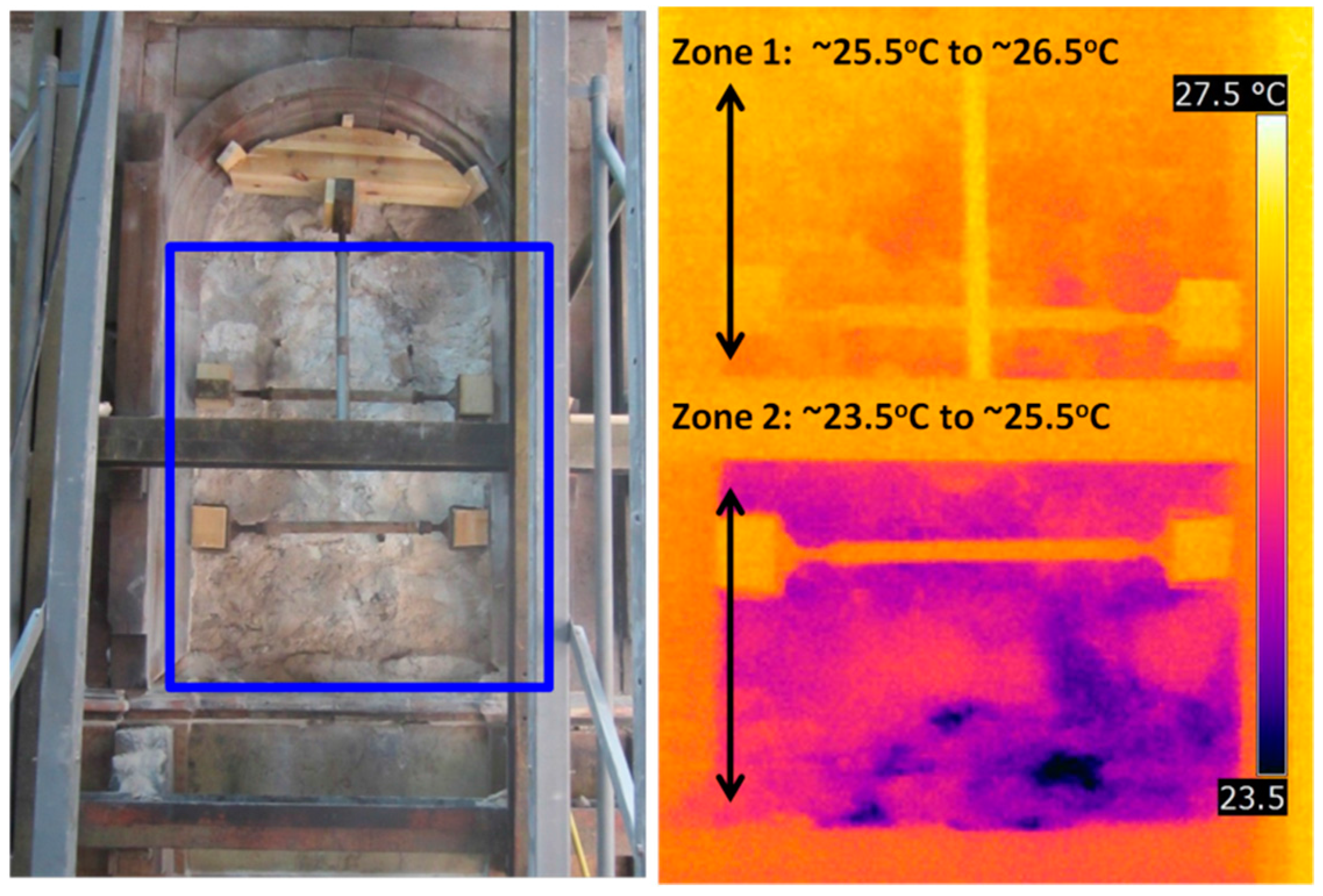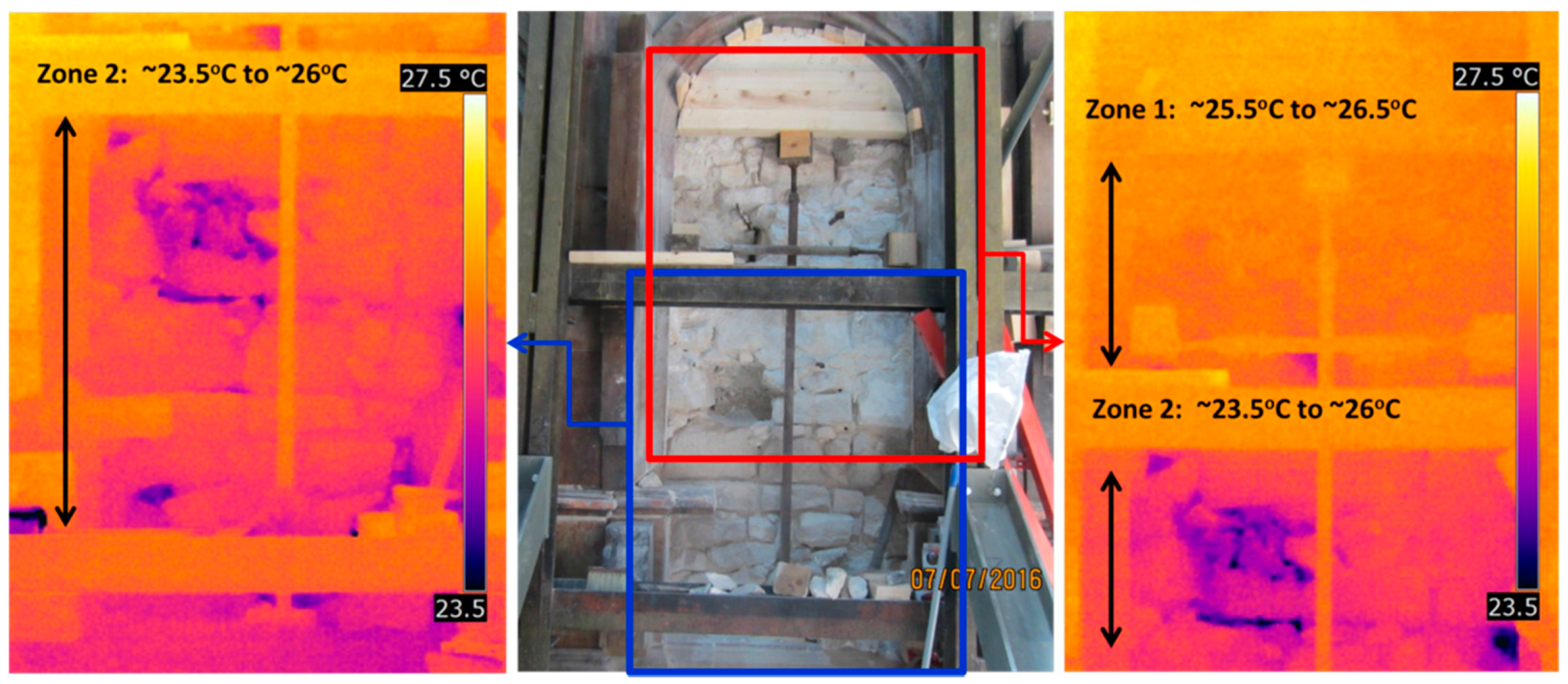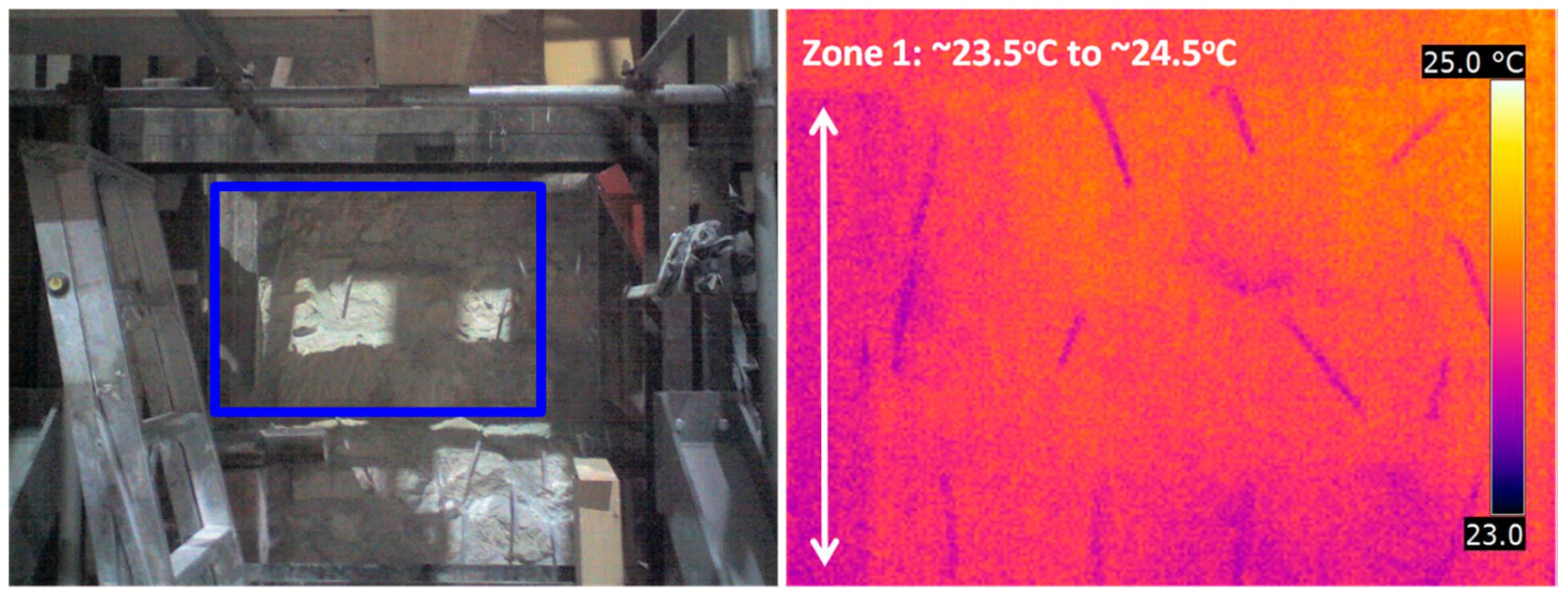1. Introduction
Infrared radiation, an invisible electromagnetic radiation, was accidentally discovered by Sir W. Herschel in 1800. At this moment, a long journey began and this invisible ‘light’ was exploited for many different applications. The first infrared thermography (IRT) systems were used for military purposes, during the First World War. In the building sector, the first applications started in the early 1980s, mostly for energy saving and insulation issues in building diagnostics [
1]. With the passage of time, there was an evolution of the various thermographic systems used, in terms of sensitivity, applicability, image processing, etc. Until now, there have been two main modes of IRT application; the passive and the active infrared thermography [
2].
Commonly, all active IRT techniques can be used in the NDT assessment of materials and also provide image processing results. Nonetheless, selection of the most suitable energy sources depends on the application. In cultural heritage applications, the most commonly used ones are optical pulsed thermography (PT) and optical lock-in thermography (LT). The first one is easy to use providing prompt results, whereas the second one permits enhanced control of the energy deposited on the material, which could be attractive if a low power source is to be employed or if distinctive attention has to be given to the investigated material (i.e., inspection of cultural heritage objects) [
3]. Through the different image processing tools that one can use (i.e., the Pulsed Phase Thermography (PPT) and Thermographic Signal Reconstruction (TSR) techniques are great examples) it allows detection of defects to certain depths (i.e., of 2.5 mm), for defects with a size-to-depth ratio of approximately 2 and higher and thus provides the user with quantitative results. In particular, image processing approaches like background subtraction [
4] or Machine Learning algorithms like expectation-maximization [
5], can reveal additional features that are not able to be detected from the original thermal image.
IRT can be used for the identification of the conservation state of a monument in real time. From its inception to the present day, the National Technical University of Athens research team have investigated many monuments belonging to different historic periods. IRT was used as a tool in the diagnostic level, for the detection of invisible superficial cracks or/and disparities, as well as the revelation of moisture presence within structures. Additionally, IRT used for the assessment of materials interventions and the determination of incompatible materials might have been utilized. Last but not least, at the Holy Aedicule rehabilitation works when it is applied for continuous monitoring, not only in real time for the detection of emergence issues that arise, but also for tracking and documenting all the interventions in every work phase [
6,
7,
8]. This scientific monitoring supported decision-making concerning the quality assessment of the integrated project of Holy Aedicule rehabilitation, contributing to the quality control of restoration and conservation interventions.
This use of IRT is currently adopted by small SMEs providing consultancy services to the stakeholders of cultural heritage. In combination with other non-destructive techniques, further information can be obtained. In this framework a new field of application in civil infrastructure has emerged for the quality control of structures like airport pavements, aircrafts, metro railways and photovoltaic panels [
9,
10].
Today, IRT is widely utilized in the sector of cultural heritage. In recent years, many researchers have used this technique all over the world, in Korea for example, at the temple of Magoksa [
11], or at the Church of the Nativity in Bethlehem [
12], or in Italy at the Longobard Temple [
13]. Furthermore, IRT can be used for the detection of various hazards, such as seismic activity, or the effect of environmental factors, which are very important issues in terms of the future of cultural heritage protection [
14]. Generally, the restoration activity and the monitoring of the intervention should be based on results of combined interpretation of thermal maps with the visual images, and integration with the aid of informatics tools.
The first NTUA pioneering applications of IRT started in the early 1990s and until now it has been used at all stages of a conservation project for the investigation of important monuments in Greece, but also beyond the borders of Greece (like Italy and Spain) and Europe (Turkey, Israel). NTUA uses IRT as a crucial part of the process of non-destructive investigation of monuments, along with other non-destructive techniques, such as portable microscope, ultrasonics, georadar, Schmitt-Hammer test, etc. [
15]. In all these years, the numeral monuments investigated belong to different historical periods, dating from antiquity (e.g., Apollo Temple in Rhodes, Temple Ifaistos in Athens ancient agora), to Byzantine (e.g., Haghia Sophia in Istanbul, Kaisariani Monastery in Athens), Medieval (Medieval Fortifications of Rhodes), to 1800s reconstructions (e.g., Holy Aedicule in the Holy Selphuchre complex), Neoclassical buildings (e.g., National Archaeological Museum in Athens) and modern cement structures (Spa Kallithea, Rhodes).
Additionally, there have been attempts to standardize this technique (e.g., estimation of the emissivity of materials, analysis of all the relevant parameters affecting the application of this technique). As an attempt to set recommendations for the most appropriate use of this technique, previous experiences led to the compilation of protocols for the technique’s application [
16].
Above all, IRT provides the thermal maps of a surface. These maps can give valuable information about heat and moisture flux and thermophysical properties of materials. All these data, with the aid of the necessary mathematical modelling, and quantitative techniques, along with integrated informatics tools, can serve as a basis for many different uses and applications, from decay diagnosis, to conservation interventions and monitoring actions. In particular, in the case of cultural heritage, this is a unique benefit, in order to scientifically support maintenance and proper decision making actions on the most compatible conservation materials and interventions and also for the monitoring and sustainability control of large-scale restoration works.
A general diagram for the application of IRT in built heritage is shown below (
Figure 1).
In this work, characteristic examples of IRT application for the protection of cultural built heritage are presented. Also, the use of IRT in large scale conservation projects is discussed. We undertake a case study on the ancient temple of Pythian Apollo in Rhodes during the diagnostic phase of the project and, before compiling the conservation interventions study, we also study the Holy Aedicule of the Holy Selphuchre in Jerusalem during different phases of the rehabilitation works.
2. Standardization of the Method-Emissivity
Surface emissivity is an important factor in IRT surveys, especially when dealing with passive thermography. Accurate temperature profiles can be obtained from such surveys as can be seen in numerous applications presented in the paper (a parameter which is taken into account in all the relevant applications, i.e., cleaning interventions, moisture detection, and consolidation treatments). In this situation, the obtained emmisivity values from the ASTM standard approach were used, but nonetheless the obtained values from the empirical approach were also taken into consideration in order to see if there is an effect on the actual outcome of the in situ thermographic surveys. Furthermore, as for Cultural Heritage materials, it is difficult to find extended literature reports with emissivity values. The two described approaches for determining emissivity on materials from historic structures give the scientist-conservator an advantage in correctly obtaining a precise temperature pattern/image.
Values for emissivity (ε) can be between 0 (perfect reflector—mirror) and 1 (perfect emmiter—blackbody). As a result, emissivity plays an essential role in infrared thermographic surveys and is dependent on temperature, wavelength and surface condition. A surface with a low emissivity value (i.e., aluminium, steel, etc.) acts as a mirror (high reflectance). However, such a problem is usually overcome using high emmittance flat paints (i.e., black colour water based paints) for painting the investigated surface(s).
Two different approaches were used for the calculation of the emissivity values on various materials. The aim was to present different ways of determining emissivity values, even for materials used in cultural heritage applications, where the literature of emissivity values is rather limited. Both approaches are presented here in order to show how this was achieved (i.e., either by using a standardized approach or even an empirical developed one). In both instances the obtained result could be used in an IRT survey. Nonetheless, the standardized procedure gives more flexibility to the thermographer-scientist as it attains values in various temperatures (this is the limitation of the empirical presented approach). The first approach was in accordance with the ASTM standard E1933–97 [
17], whereas the second one was completed according to an empirical procedure [
18]. In the case of the empirical approach, a piece of electrical tape (3M Scotch Super 88 Vinyl) with a known emissivity of 0.95, at 48.88 °C was attached as a reference emitter to the investigated sample(s).
Batches of three specimens (
Table 1) were measured using mid and long wave IRT (AVIO TVS-2000 Mk II LW, Nippon Avionics Co, Tokyo, Japan) (3–5.4 μm and 8–12 μm), at numerous temperatures. The importance of emissivity in IRT building surveys was seemingly acknowledged.
A non-contact thermometer (Gann IR40, Gann, Gerlingen, Germany) was also utilised to confirm that the examined specimens were in a thermal equilibrium state while inside the chamber. The IRT systems (AVIO TVS-2000 Mk II LW, Nippon Avionics Co, Tokyo, Japan) were then adjusted in order to determine the materials’ emissivity values. To overcome the problem of moisture (porous materials), the samples were first heated at a temperature of 105 °C for a period of 24 h and then were stored in a desiccator for at least two hours.
Figure 2 shows the emissivities of the investigated materials using both approaches. The standardized approach has more advanced analysis as it can obtain emissivity values at various temperatures when compared to the empirical developed approach. Furthermore, the results presented in the MWIR (i.e., 3–5.4 microns) show greater variability than in the LWIR (i.e., 8–12 microns). This leads us to conclude that the empirical approach is more suited for use in IRT surveys employing LWIR rather than in MWIR investigations.
3. NDT and E of Defects in Building Materials
Active thermography was used in the inspection of three variations of porous stone and one type of marble with the intention to non-destructively detect defects by modelling and experimental procedures. All stones were sandstones from different areas. First one, Rhodes sandstone, was a calcareous porous stone of grey colour, containing 77% of CaCO3. The second one, Cyprus sandstone, was again a calcareous porous stone of grey colour, containing 48% of CaCO3, whilst the third one, was a white-coloured calcareous porous stone containing high percentage of CaCO3. The fourth investigated material was the Dionysus marble, a white-coloured marble containing mostly calcite (98%).
All samples enclosed self-induced defects of square geometry with known dimensions and at specified depths. The dimensions of the samples were: 15 cm × 15 cm × 4 cm. Two samples from each material were tested. The first one contained three defects of 2 cm (size) at depths of 2.5 cm, 3 cm and 3.5 cm and the second one, again with three defects of 1 cm, 2 cm and 3 cm big but this time at the same depth (3 cm). The samples were heated externally and a sequence of thermograms was recorded at the transient phase.
We also applied mathematical-thermal modelling that enabled the modelling of the investigated subsurface defects, using the Thermocalc 3-D software. We also undertook quantification analysis (i.e., temperature-time plots, as well as thermal contrast curves) from the experimental work, as well as from the modelling, showing the thermal performance of building materials containing such defects (
Figure 3,
Figure 4 and
Figure 5). In
Figure 5 shows the two different materials and their investigated defects.
The samples were inspected taking into account the physical and thermal properties of the materials, as well as using specified heating parameters, in order to match the outcome of a transient thermography assessment.
A pulsed thermal source was employed for the excitation process, using optical lamps of 1000 W (2 × 500 watts). The heat time, end time and time step were 2360 s, 4830 s and 10 s respectively.
Temperature—time plots (
Figure 6), as well as the contrast of the thermal images of the subsurface defects in relation to time were measured (plots of contrast vs. time). Information concerning the defects was obtained from the processed thermograms. The temperature-time plots from the acquired thermograms were also plotted (
Figure 7). Such quantitative data could provide information concerning the detected defects. Furthermore, thermal diffusion of air (m
2/s) is lower than that of any of the investigated building materials (i.e., porous stone, marble). This means that regularly defected areas would be presented with higher temperature values [
19].
4. IRT Different Case Studies from Diagnosis to Protection Interventions
4.1. Decay Diagnosis/Identification of Different Construction Phases
Diagnosis is one of the first phases of a conservation project. It is achieved through a survey in situ, including inspection and non-destructive investigation, followed by sampling and further analysis. A combination of various NDTs is necessary in order to extract significant and useful results. As a recent example shows, for the case of Kaisariani Monastery (11th or 12th cen.), a UNESCO mid-byzantine Monastery, where after an in-situ optical inspection, different NDTs were applied, such as: Ground-penetrating Radar (GRP), IRT (FLIR B200 Western, Agema Sweden, 7.5–13 μm), Fiber Optics Microscopy (FOM) and Schmidt rebound Hammer test.
In this case, the main interesting finding was that, with the aid of NDTs, especially with the application of IRT, it was possible to identify the different construction phases based on the different temperatures of the different materials used, like mortars and ceramic bricks (
Figure 8). For example, restoration bricks were identified, which presented different temperatures to the authentic ones. Restoration bricks presented lower temperatures (~17 °C) in comparison to the historic ones (~21 °C). The date the thermogram was taken was 17.02.2014, with air temperature Τ = 12 °C, RH = 52%.
Moreover, the presence of moisture and different types of surface decay, were also investigated [
20].
4.2. Moisture Detection
Moisture is well known to be the most deteriorating factor of building materials [
21]. IRT is a reliable technique for moisture detection [
22], as it can distinguish between wet and dry by measurements of the thermal variations and can provide a clear indication of moisture movement and impact (i.e., moisture damage) in porous materials, based on emittance variations. The study and interpretation of an obtained thermal image could provide information on the moisture movement and impact to porous media.
Below are shown two different cases, a study that tested salt damp movements in the laboratory and in situ in the medieval wall masonries in Rhodes, with the use of AVIO TVS-2000 Mk II LW, 8–12 μm. The first one involves the use of IRT for monitoring a capillary rise of sodium sulphate ageing test, for brick-plasters systems (
Figure 9) with various coatings [
23].
As shown in
Figure 10, with the aid of IRT, it was possible to monitor the salt solution movements at the brick-plaster system. The thermal image corresponds to the profile of the brick-plaster for four different plasters. It can easily be seen which of the plasters favours the salt solution transportation to the front side of the system (central two samples) and for which the salt solution goes up to the brick (the one on the left of the thermal image (point 1) and the other at the fight side (point 2)). The air temperature was ~20 °C and relative humidity ~50%.
Moreover, in the following images we show the use of this technique on the masonry of the medieval complex of the island of Rhodes. This masonry is located at the moat and rising damp is one of the main causes of decay. A west-orientated masonry (
Figure 11 and
Figure 12) comprised of consistently sized untreated stones was investigated. The back face of the masonry is constantly fed by salt solution due to the presence of the sea. The salt action is verified by the presence of efflorescence, while the extended recession of the surface is proved by the accumulation of disintegrated stone granules on the basis of the masonry.
The obtained thermal image presents temperature variations on the surface of the investigated masonry, indicating the presence of humidity loads within the porous stones. The ambient conditions during the investigation were air temperature ~22 °C and air relative humidity of 60%. The presence of moisture (lower temperatures on the infrared image) that arises as a result of the capillary movement of water has caused deterioration of the porous stone masonry. This is mainly because, during water movement inside the pores, there is also a movement of salts (from the presence of sea). Since such porous stones have high porosity values and large amounts of large pores that trigger capillary action, water movement inside their porous systems occurs [
22,
24].
4.3. Assessment of Conservation Interventions
IRT is also a very important tool in the assessment of various conservation interventions. Selected cases of application are reported concerning the study of restoration mortars, consolidation materials, cleaning and protection materials and techniques.
4.3.1. Restoration Mortars
In 2010–2011, there was a diagnostic campaign at the Church of the Holy Sepulchre in Jerusalem, with three main areas of interest: inside the Catholic of the Greeks, at the Dome of the Catholic and at the Bell tower. One of the main purposes of that investigation was to allocate and to investigate the compatibility of restoration plasters to the original ones.
During the diagnostic survey of the Church of the Holy Sepulchre in Jerusalem, Non-Destructive Testing was applied in order to determine and map the incompatible materials used for its conservation and structural maintenance. These techniques occurred in the following areas of the Temple: inside the Catholic of the Greeks, at the Dome of the Catholic and at the Bell Tower. IRT indicated the difference in the surface temperature of restoration mortars applied in the masonry at both the Dome and the Bell Tower. This difference implies a possible differential behaviour during thermal contractions-expansions that may result in a considerable loss of the masonry’s compressive strength [
25].
Figure 13 presents a characteristic area of investigation at the Dome of the Greek Catholic, as well as the corresponding thermal image. In the thermal image, temperature differences are investigated depending on the surface type of decay (stone mass loss, crusts, etc.). In general, the restoration mortars present higher temperatures [
25]. The thermogram was taken on 27 January 2011, at 17:00, with air temperature ~13 °C and air relative humidity ~60%.
4.3.2. Consolidation Interventions
The application of a consolidation material aims to restore the cohesion of a weathered stone. A consolidant should fulfil specific requirements that deal with the change in the porous structure of the stone, the impact in moisture transfer and compatibility with the authentic structure.
Stone consolidation is quite a risky conservation intervention. Nonetheless, it is a necessary intervention since stones decay and loose cohesion in the exposed surfaces down to a certain depth. Many consolidation materials form a film on the surface of the stone that obstructs the conventional transport of water-moisture via the capillary systems within the stone(s). However, the evaporation of water should usually also be considered, especially in cases where intense environmental conditions are present (i.e., high winds, elevated temperatures) as these accelerates the evaporation rate, leading to the formation of salt efflorescence and crystallisation and, thus, accelerated damage for the structure.
A consolidant must be hydrophilic allowing the water to pass through the treated layer of the stone. It must also have the ability to penetrate the stone (i.e., low viscosity), and it should not present or cause any colour alterations to the stone. There are various application techniques for stone consolidation. Commonly, they are applied to the surface of the stone by brush, spray, pipette, or by immersion, and are drawn into the stone by capillarity.
In this work, IRT (AVIO TVS-2000 Mk II LW, 8–12 μm) was used in the investigation of consolidated porous stone structures. It has been shown that, due to the difference between the thermal diffusivities of consolidated and untreated stones, thermography is capable of imaging large areas and displaying qualitative dissimilarities in penetration depth these emerge as surface temperature variations on the obtained thermal images. It has also been shown that simulating work in the laboratory can be important in order to interpret the results properly as far as a consolidation treatment is concerned.
The masonry is orientated in a south-easterly direction. The materials used were silicon-based materials since they present good compatibility with the stone and chemical stability owing to the Si–O–Si bond, preventing discolouration. Furthermore, due to the low viscosity of these products, they provide deep penetration in the stone. The capillary system of the stone in combination with the low viscosity of the solutions used, facilitated the application of spraying; the products are presented in
Table 2.
Thermal images were acquired 3, 15, 28 and 33 months after the consolidation treatment. Below a representative result from a thermographic survey from the investigated masonry (
Figure 14) 3 months after the consolidation treatment (
Figure 15) is presented.
Different temperatures at the same height of the stonework were noticed, due to the use of the various consolidants (air temperature 13 °C, relative humidity ~65%). Although the images were acquired at different times/seasons, it can be said that treatments with RP and EU present relatively higher temperatures when compared to the treatments with PH and PL. This is probably due to the fact that the first two treatments amend the respiration of the stones.
It can thus be concluded that the different temperatures among the consolidated areas of the examined masonry are due to the physico-chemical variations that the consolidants present in comparison to the authentic stone. The RP and EU areas obstruct the pores of the stone, whilst PH and PL treatments present physico-chemical compatibility to the stone [
26].
4.3.3. Cleaning Interventions of Architectural Surfaces
The cleaning of stone and architectural surfaces results in aesthetic and physicochemical alterations to the applied surface. According to the British Standard 8221-1:2000 [
27], buildings are cleaned either to enhance their appearance (i.e., removal of disfigurements, reveal the natural colour/details of building, restoration of building appearance that has been altered/repaired) or to assist maintenance and/or conservation (i.e., removal of harmful substances in order to arrest decay, exposure of concealed defects to establish the extent and nature of necessary repairs, preparation of surface for additional treatments, fulfilment of the terms of a lease that requires periodic cleaning of a building).
There are various cleaning techniques, ranging from those that are intended for use on large facades to those that are intended for meticulous use on finely carved and delicate sculpture. Their efficiency is commonly assessed subjectively. IRT can be employed in order to assess any surface alterations (i.e., roughness) after a cleaning application [
28], as well as to investigate any moisture deposits in the examined surfaces.
In this case, IRT (AVIO TVS-2000 Mk II LW, 8–12 μm), was used with the intention of investigating the efficiency of specific cleaning treatments on certain architectural surfaces of different materials and decay patterns at the historic Bank of Greece building in Athens. The cleaning methods applied on the architectural surfaces were either distilled water with controlled pressure or sepiolite poultices. In
Figure 16, we present: a white Pentelic marble surface (left), a metamorphic limestone consisting almost exclusively of calcite grains and quarried from mountain Penteli in Athens and the investigated porous stone surface (Kapandriti’s stone), consisting mainly of calcite minerals and quarried from the Kapandriti area in Attica (right).
From the acquired thermograms (
Figure 17 and
Figure 18), different temperatures can be observed on the surfaces according to the applied cleaning method. The air temperature was about 16 °C and air relative humidity was 55%. Sepiolite residues were traced on the cleaned architectural surfaces by poultices (left side of thermograms), leading to a withholding of moisture and therefore lower temperatures on the thermograms compared to the cleaned areas on the right (i.e., distilled water with controlled pressure). A thorough water rinse should take place whenever sepiolite poultices are applied for cleaning, while the use of Japanese paper between the poultice and the material to be cleaned is also recommended. Furthermore, the sepiolite poultices should be covered with polyethylene film so as to prevent swift water vaporization when at high temperature and low humidity conditions that leads to the hardening of the sepiolite on the stone.
4.3.4. Evaluation of Protection Interventions
The historic building of National Archaeological Museum (NAM) is located in the centre of Athens, and it was constructed in 1889. The western (main) façade of NAM consists of several types of plasters and pentelic marble surfaces (
Figure 19). During the diagnostic study performed for the characterization of building materials and decay diagnosis, the purple masonry historic plaster, which is located on propylaem and galleries of the main façade, was examined [
29].
The plaster under investigation was of marmorino type (lime binder with fine grained calcite aggregates), and its purple colouring was attributed to the natural earth pigment of Fe
2O
3 [
30]. However, major discolorations were observed all over the purple plastered architectural surfaces of the NAM propylaem and galleries because of the poor preservation state of a coating applied during previous protection interventions. Digital microscopy was applied on the plastered surfaces under investigation, demonstrating that, at some areas of the plastered surfaces, the protective coating was firmly attached to the substrate (
Figure 20, top row, left), while at other areas, the coating was friable, loosely attached to the substrate, and presented a whitish hue (
Figure 20, top row, right). Furthermore, in many cases, the protective coating was fractured and detached from the substrate, presenting a yellow hue (
Figure 20, low row, right and left).
IRT investigation (AVIO TVS-2000 Mk II LW, 8–12 μm) took place when no direct sunlight was affecting the plastered architectural surfaces (
Figure 21, environmental conditions: T = 22.5 °C, RH = 53%). It was shown that the areas of fractured, detached, friable and loose coating presented higher temperatures (from 24.2 °C to 25 °C) compared with areas of firmly attached coating (temperature readings from 21.73 °C to 22.53 °C). In particular, the areas where the protective coating is fractured and detached from the plaster are depicted by yellow and red colours, while the areas of friable and loosely attached coating are rendered by purple colours. The areas displayed by blue and black colours correspond to the coating firmly attached to the plaster.
This non-uniform temperature distribution is attributed to moisture withholding because of the protective coating application (a material of organic composition) that constrained the substrate transpiration, which affected its vapour permeability. Therefore, in addition to the inspected discolorations, the applied protective coating presented physicochemical incompatibility to the substrate. During the planning phase of the conservation interventions on the NAM’s architectural surfaces, the decision was made to remove this coating.
5. Thermographic Examination of Mosaic Surfaces
Hagia Sophia in Istanbul is a unique monument with invaluable assorted mosaic categories. The NTUA research team had the opportunity to study Hagia Sophia mosaics in 2000 [
31] and in 2010 [
32].
In the first case, IRT (AVIO TVS-2000 Mk II LW, 8–12 μm) was used along with other non-destructive techniques in an attempt to investigate the plastered surfaces of dome mosaics. Interventions in the past have triggered aesthetic problems leading in some cases to severe damage of the mosaics. Such an example is the intervention that occurred in the early 1900s, under the General Directorate of Pious Foundations, mostly known as the “Vakif intervention”. The plaster of this intervention was covered with an opaque yellow pigment in a glue medium. A pattern of stencil ornaments was applied on this yellow ground [
33]. In this work, a plastered mosaic surface (characteristic Vakif intervention surface) in the Hagia Sophia dome was investigated. The surface was situated between the 19th and the 20th rib at the northwest part of the dome, 16 m from the centre of the dome.
Figure 22 shows the examined surface whilst a thermal image obtained from the investigation of this surface is shown in
Figure 23, in order to reveal the mosaic tesserae beneath the plastered surfaces. Due to the different thermal diffusion that each layer renders, IRT was able to detect the different sub-surfaces on the plastered mosaics by presenting the temperature variations on the surfaces. This was accomplished after employing the active thermographic approach, using an external optical heat source in order to uniformly heat the inspected panels.
The surface was heated with optical lamps (1000 watts power output from a distance of 50 cm), and the presented thermal image was obtained during the cooling down process. The image illustrates the existence of the coated mosaic, as well as the detached area within it. Darker grey areas, i.e., lower temperature values, represent the mosaic. The detached areas, behaving similar to a sub-surface defect, hold remarkably higher temperature values due to the different thermal diffusion rate (thermal contrast). The higher temperature of the detached area was between 0.8 and 1 °C.
On the second visit, IRT (FLIR B200 Western, 7.5–13 μm) along with other non-destructive was were applied to investigate the mosaics in the galleries. The main aim of this on-site investigation was to evaluate the preservation state of the mosaics and the previous interventions, as well as to detect mosaics in layers below the external plastered surfaces. The results indicated that, with the aid of NDT, it is indeed possible to locate the grid of rendered mosaics. Additionally, we identified the main environmental decay factors (moisture, salt, pollutants), the areas where the mosaic materials (tesserae and bedding mortars) presented decay problems and sub-layers that pose risk of detachment or decay intensification.
In
Figure 24, we present our investigation of an area of the mosaic of Constantine IX Monomachos and Augusta Zoe. This mosaic was rediscovered by the Byzantine Institute in 1934. The lower part of the mosaic is missing. In this case, IRT was applied in order to diagnose the preservation state of the mosaic. This mosaic is located on the interior of an east external masonry, and a past cement intervention is present at its lower part. With the aid of IRT, we investigated areas with different temperatures at the bedding cement mortar, but also at the existing tesseraes. These temperature differences can be attributed to the action of the main deterioration factors, such as the presence of salts and moisture. The air temperature was 23 °C and the relative humidity was 70%. In the following microscopical image (×30) (
Figure 25), it can be observed the areas with grey tesserae presented extended surface spalling and salt efflorescences.
6. Integrated Large-Scale Conservation Projects
6.1. During Decay Diagnosis: The Case of Pythian Apollo Temple in Rhodes
In the case of the Temple of Pythian Apollo of Rhodes, IRT was used as a part of a large-scale restoration project. The IRT was initially used at the diagnostic campaign, before the compilation of the conservation interventions study, which will be accomplished by Dodecanese Ephorate of Antiquities.
The Temple of Pythian Apollo of Rhodes is located in the southern area of the Acropolis of the island and dates from the 3rd century BC. It is a peripteral Doric order temple, with dimensions of 20.05 m in width and 37.37 m in length, which consists of 6 columns on the small side and 11 on the long side [
34]. The temple is orientated from east to west and is entrenched in an artificially shaped rock at its centre [
35]. During the first Italian excavations (1912–1936), pieces from the ruins of the temple were revealed. The complete anastylosis of four columns and part of the entablature on the eastern corner of the temple began in 1938 (
Figure 26), although the experts, headed by the archaeologist Paolini [
35], were not sure about the original architectural morphology of the temple. The authentic stone material that was found (a fossil ferrous biocalcarenite stone) was limited. Thus, the restoration works were performed using either an artificial stone made of concrete, or biocalcarenite restoration stones. Concrete and cement products were also used in order to fill the drums (
Figure 27). The stone core of the shafts was removed, and reinforced concrete was injected into it. Moreover, cement mortars, metal joints and lattices have been used for the mechanical support and stabilization of the stones. In recent years, scaffolding was put in place by the Greek archaeological service (
Figure 28).
In this case, IRT was used in the diagnosis of the monument’s state of conservation. Firstly, IRT was applied in order to investigate the different materials, especially to identify the authentic stone pieces and the different types of decay. Moreover, it was used to detect moist areas, since the temple is located very close to the sea and in contact with possible underground water sources. Other non-destructive techniques were also applied in situ with portable devices like a digital microscope, Schmidt hammer test, thermohygrometer and colorimeter. Moreover, after sampling, analytical techniques such as optical microscopy, X-Ray Diffraction analysis (XRD), Differential Thermal analysis (DTA)/Thermogravimetry Analysis (TG), Scanning Electron Microscopy (SEM) coupled with Energy Dispersive X-Ray Spectrosopy (EDAX) and total soluble salts measurements were used. Metric results were concluded in the GIS program [
36], from each implemented technique of the diagnostic study [
37]. Finally, finite element analysis (FEM) was performed and, by coupling all the results, final conclusions were derived [
37].
During the IRT investigation, multiple peripheral thermal scanning measurements of the columns and the stairs of the monument were performed every hour of every day. Also, a portable thermo-hygrometer (Flir, model MR77) was used in order to calibrate the infrared camera temperature indications and to evaluate the variations of materials temperature and moisture content with height. In this way, thermal maps of the columns were created.
Table 3 shows the air temperature and relative humidity during image captions.
More specifically, thermal incompatibility of the materials was noted in all the thermographs because the rehabilitation materials presented higher temperatures than the antique ones (
Figure 29). The cracks, the cellulosic material and the loss of materials (
Figure 30) are noted in the thermographic images as having lower temperatures. The edges of the shafts are noted in the thermographic images as having higher temperatures (
Figure 31). This anisotropic thermal distribution (
Figure 32) may cause a non-uniform mechanical stress distribution.
Moreover, the evaluation of the moisture content of the materials was performed. More specifically, the moisture content of the materials was reduced vertically in the column, from bottom to top, due to the possible presence of rising damp. Αt specific points on the steps of the temple, with rising salt damp phenomena (
Figure 33), the development of mosses was macroscopically observed. In the corresponding thermogram (
Figure 34,) these areas were inspected with lower temperatures.
After the research, it became clear that the main type of decay was stone mass loss due to the extended use of incompatible conservation materials and techniques, along with the effect of the environmental decay factors such as a marine environment with strong winds. Taking all the above into consideration, it is proposed that the existing cement filling mortar has to be removed because it caused and intensified the decay phenomena and it was aesthetically incompatible with the original stone. In addition, it is suggested that the mechanical reinforcement of the columns has to be performed by using a compatible restoration mortar, such as titanium at the core of the columns, the use of injections in order to restore the consistency of the mass of stones and the fitting of new compatible rehabilitation stone blocks. According to the literature [
38], the use of cement mortar is considered totally incompatible with this limestone. Finally, in agreement with the measurements that were made, the compatible remediation mortars are the hydraulic lime mortars, the calcium mortars and the lime-pozzolan mortars.
6.2. During the Rehabilitation Works: The Case of the Holy Aedicule of the Holy Sepulchre in Jerusalem
The Holy Aedicule is an indoor monument located in the Church of the Holy Sepulchre in Jerusalem. It is the place where Jesus Christ is believed to be buried and resurrected, according to Christian tradition.
IRT was used for monitoring the works’ progress throughout the rehabilitation phases of the Holy Aedicule of the Holy Sepulchre in Jerusalem (
Figure 35) in the recently completed rehabilitation project, undertaken by the NTUA Interdisciplinary Team for the Protection of Monuments [
39]. IRT application, undertaken in real time during the construction works, enabled (a) the evaluation of the preservation state of several historical building elements that could not be examined at the diagnosis phase, as well as (b) the assessment of the application of several conservation intervention materials [
40].
A characteristic example of IRT (FLIR B200 Western, 7.5–13 μm) application on the panel areas during different rehabilitation phases is presented in this work.
At the beginning of the rehabilitation project, certain areas of the external façade stones (named stone panels and depicted in
Figure 35) were disassembled. IRT was employed to study and assess the preservation state of the filling mortar that was found underneath the removed panel stone slabs. The filling mortar layer was found to be highly disintegrated and to have partially collapsed in many panels. IRT investigation of the N2 panel (second panel of the north façade, numbered from the east) indicated intense rising damp from the underground through the capillary rise (
Figure 36 under the following environmental conditions: T = 26 °C, RH = 60.4%, June 2016). Two distinctive temperature zones were detected corresponding to the lower and the upper masonry parts, with the lower masonry part presenting lower temperatures. In particular, the lower masonry part (zone 2) presented temperatures of approximately 23.5 °C to 25.5 °C, whereas the upper masonry part (zone 1) displayed temperatures of approximately 25.5 °C to 26.5 °C. The temperature distribution was not found to be homogenous, which indicates anisotropy regarding the moisture transfer phenomena and thus explains the poor preservation state of the filling mortar layer.
A rubble-type of masonry was revealed, when the disintegrated filling mortar layer was removed. Two distinct temperature zones were still evident in the panel under investigation after the filling mortar removal, as IRT results demonstrated (
Figure 37, environmental conditions: T = 26 °C, RH = 53%, July 2016). The lower masonry part (zone 2) presented lower temperatures compared to the upper masonry part (zone 1). The N2 panel masonry withheld moisture at its lower part and thus inhomogeneous temperature distribution among the historic building materials was displayed.
During the following phase of the rehabilitation works, the joints were cleaned and the masonry was repointed in depth. While applying a compatible and performing restoration mortar (a commercial lime-metakaolin based material), grout injection tubes were installed [
41]. IRT showed that, after repointing, the temperature distribution width of the area under investigation was approximately 1 °C. Before the application of the restoration mortar, the same N2 panel area presented a temperature distribution width of approximately 2.5 °C (
Figure 37 and
Figure 38 respectively). Therefore, the temperature distribution width became tighter compared to the one that this masonry part displayed before the repointing, indicating compatibility among restoration mortar, building stones and historic mortar.
However, the lower masonry part of the N2 panel (zone 2) continued to present lower temperatures (slightly lower though) compared to the masonry part above, showing that capillary rise from the ground continues to affect the restored masonry (
Figure 39).
Summarizing the above results, it is evident that one of the main causes of the deterioration of the masonry is the intense rising damp from underground. Furthermore, IRT demonstrated that rising damp is found in the lower parts of the historical masonry, before and after repointing, indicating that moisture is a major environmental load with a continuous negative impact on the structure. Thus, the IRT investigation of the rising damp was instrumental in the decision-making process during the rehabilitation project, as it led to a survey of the Holy Aedicule’s underground area to identify moisture sources and propose appropriate measures. Finally, IRT confirmed the compatibility of the applied restoration mortar with the historical building elements.
7. Conclusions
NTUA’s long experience and the vast areas of the various applications, demonstrates the significance of IRT application at all stages of a conservation project, from diagnosis to evaluation of conservation interventions, for ordinary or large-scale conservation projects. The main products of IRT, thermal maps of surfaces, are evaluated and exploited, based on the demands, special needs and requirements of each application.
Moreover, IRT can be used as a tool for the scientific monitoring and to support decision making during the progress of a project. Today, the necessity of creating corresponding georeferences of the areas under examination is emerging, in order to support strategic planning and protection of cultural heritage assets. The work presented here, based on novel investigations and understanding of IRT results in cultural heritage applications, promotes the use of the technique by making it available to researchers in the field to facilitate further development of applications of IRT. Therefore, it enhances the significance to today’s scientific research in the area of NDT imaging in cultural heritage applications.
Acknowledgments
The study and the rehabilitation project of the Holy Aedicule became possible and were executed under the governance of His Beatitude Patriarch of Jerusalem, Theophilos III. The Common Agreement of the Status Quo Christian Communities provided the statutory framework for the execution of the project; His Paternity the Custos of the Holy Land, Archbishop Pierbattista Pizzaballa (until May 2016—now the Apostolic Administrator of the Latin Patriarchate of Jerusalem), Fr. Francesco Patton (from June 2016), and His Beatitude the Armenian Patriarch of Jerusalem, Nourhan Manougian, authorized His Beatitude the Patriarch of Jerusalem, Theophilos III, and NTUA to perform this research and the project. Contributions from all over the world secured the project’s funding. Worth noting Mica Ertegun’s and Jack Shear’s donations through WMF, Aegean Airlines et al. The interdisciplinary NTUA team for the Protection of Monuments, Em. Korres, A. Georgopoulos, A. Moropoulou, C. Spyrakos, Ch. Mouzakis, were responsible for the rehabilitation project and A. Moropoulou, as Chief Scientific Supervisor, was responsible for its scientific supervision. Also, special gratitude should be given to Dodecanese Ephorate of Antiquities, for giving the permission to NTUA research time to participate in the diagnostic study of the Pythian Apollo Temple in Rhodes Island.
Author Contributions
A.M. is the scientific responsible of this work. She supervised all the related research projects. All the other authors participated in different projects, for example N.P.A. was one of the first in the team that designed and performed different experiments from emissivity, to moisture detection and consolidation. Together with M.K. and E.T.D. they work for the examination of mosaics. Later on M.K. along with E.T.D. were responsible for mosaic examinations and also with Holy Selphuchre Temple investigation. Each one of them worked also on different areas, for example M.K. for salt damp detection, to different materials investigation and E.T.D. for protection materials assessment. Members that added quite recentely in the teal are E.A. and B.K.; E.A. who worked with E.T.D. at the Holy Aedicule and B.K. with M.K. at the Temple Apollo in Rhodes respectively.
Conflicts of Interest
The authors declare no conflict of interest.
References
- Kylili, A.; Fokaides, P.A.; Christou, P.; Kalogirou, S.A. Infrared thermography (IRT) applications for building diagnostics: A review. Appl. Energy 2014, 134, 531–549. [Google Scholar] [CrossRef]
- Mercuri, F.; Cicero, C.; Orazi, N.; Paoloni, N.S.; Marinelli, M.; Zammit, U. Infrared Thermography Applied to the Study of Cultural Heritage. Int. J. Thermophys. 2015, 36, 1189–1194. [Google Scholar] [CrossRef]
- Ibarra-Castanedo, C.; Piau, J.M.; Guilbert, S.; Avdelidis, N.P.; Genest, M.; Bendada, A.; Maldague, X.P.V. Comparative study of active thermography techniques for the nondestructive evaluation of honeycomb structures. RNDE 2009, 20, 1–31. [Google Scholar] [CrossRef]
- Makantasis, K.; Nikitakis, A.; Doulamis, A.; Doulamis, N.; Papaefstathiou, Y. Data-Driven Background Subtraction Algorithm for in-Camera Acceleration in Thermal Imagery. IEEE TCSVT 2017. [CrossRef]
- Elguebaly, T.; Bouguila, N. Finite asymmetric generalized gaussian mixture models learning for infrared object detection. Comput. Vis. Image Underst. 2013, 117, 1659–1671. [Google Scholar] [CrossRef]
- Ioannides, M.; Alexakis, E.; Coughenour, C.M.; Vincent, M.L.; Gutierrez, M.F.; Lopez-Menchero Bendicho, V.M.; Fritsch, D.; Moropoulou, A.; Rajcic, V.; Zarnic, R. Digital cultural heritage—A challenge for the chemical engineering: Contextualizing materials in a holistic framework. In Emerging Technologies in Non—Destructive Testing VI. In Proceedings of the 6th International Conference on Emerging Technologies in Non-Destructive Testing, Brussels, Belgium, 27–29 May 2015; ISBN 978-1-138-02884-5. [Google Scholar]
- Sfarra, S.; Ibarra-Castanedo, C.; Ambrosini, D.; Paoletti, D.; Bendada, A.; Maldague, X. Non-Destructive Testing Techniques to Help the Restoration of Frescoes. AJSE 2014, 39, 3461–3480. [Google Scholar] [CrossRef]
- Ibarra-Castanedo, C.; Sfarra, S.; Klein, M.; Maldague, X. Solar loading thermography: Time-lapsed thermographic survey and advanced thermographic signal processing for the inspection of civil engineering and cultural heritage structures. Infrared Phys. Technol. 2017, 82, 56–74. [Google Scholar] [CrossRef]
- Moropoulou, A.; Avdelidis, N.P.; Koui, M.; Kakaras, K. An application of thermography for detection of delaminations in airport pavements. NDT&E Int. 2000, 34, 329–335. [Google Scholar]
- Moropoulou, A.; Avdelidis, N.P. Active thermography in the assessment of aircraft repaired panels. Bindt 2002, 44, 145–150. [Google Scholar]
- Jo, H.; Lee, C.H. Quantitative modelling and mapping of blistering zone of the Magoksa Temple stone pagoda (13th century, Republic of Korea) by graduated heating thermography. Infrared Phys. Technol. 2014, 65, 43–50. [Google Scholar] [CrossRef]
- Faella, G.; Frunzio, G.; Guadagnuolo, M.; Donadio, A.; Ferri, L. The Church of the Nativity in Bethlehem: Non-destructive tests for the structural knowledge. J. Cult. Herit. 2012, 13, e27–e41. [Google Scholar] [CrossRef]
- Becherini, F.; Bernardi, A.; Di Tuccio, M.C.; Vivarelli, A.; Pockelè, L.; De Grandi, S.; Fortuna, S.; Quendolo, A. Microclimatic monitoring for the investigation of the different state of conservation of the stucco statues of the Longobard Temple in Cividale del Friuli (Udine, Italy). J. Cult. Herit. 2016, 18, 375–379. [Google Scholar] [CrossRef]
- Sfarra, S.; Ambrosini, D.; Paoletti, D.; Nardi, I.; Pasqualoni, G. The hybrid thermography approach applied to architectural structures. In Proceedings of the SPIE Optics for Arts, Architecture, and Archaeology VI, Munich, Germany, 11 July 2017; Volume 103310V. [Google Scholar] [CrossRef]
- Moropoulou, A.; Labropoulos, K.; Delegou, E.T.; Karoglou, M.; Bakolas, A. Non destructive techniques as a tool for the protection of built cultural heritage. Constr. Build. Mater. 2013, 48, 1222–1239. [Google Scholar] [CrossRef]
- Kioussi, A.; Skordaki, N.; Karoglou, M.; Moropoulou, A. Integrated Protocol for Non-Destructive Testing Investigation of Historic Buildings. Sens. Lett. 2015, 13, 565–572. [Google Scholar] [CrossRef]
- American Society for Testing and Materials (ASTM). Standard Test Methods for Measuring and Compensating for Emissivity Using Infrared Imaging Radiometers; E1933-97; American Society for Testing and Materials: Pennsylvania, PA, USA, 1997. [Google Scholar]
- Madding, R.P. Emissivity measurement and temperature correction accuracy considerations. In Thermosense XXI; LeMieux, D.H., Snell, J.R., Eds.; International Society for Optics and Photonics: Bellingham, WA, USA, 1999; pp. 39–47. [Google Scholar]
- Avdelidis, N.P.; Moropoulou, A.; Stavrakas, D. Detection and quantification of discontinuities in building materials using transient thermal NDT techniques: Modelling and experimental work. J. Mater. Eval. 2006, 64, 489–491. [Google Scholar]
- Moropoulou, A.; Apostolopoulou, M.; Moundoulas, P.; Karoglou, M.; Delegou, E.T.; Lampropoulos, K.; Gritsopoulou, M.; Bakolas, A. The combination of NDTs for the diagnostic study of historical buildings: The case of Kaisariani Monastery. In Proceedings of the COMPDYN 2015, 5th ECCOMAS Thematic Conference on Computational Methods in Structural Dynamics and Earthquake Engineering, Crete Island, Greece, 25–27 May 2015. [Google Scholar]
- Moropoulou, A.; Karoglou, M.; Bakolas, A.; Krokida, M.K.; Maroulis, Z.B. Moisture Transfer Kinetics in Building Materials and Components: Modelling, Experimental Data, Simulation, New Approaches to Building Pathology and Durability. In Drying and Wetting of Building Materials and Components, 1st ed.; Delgado, J.M.P.Q., Ed.; Springer: Berlin, Germany, 2014; Chapter 2; pp. 27–50. [Google Scholar]
- Avdelidis, N.P.; Moropoulou, A.; Theoulakis, P. Detection of water deposits and movement in porous materials by infrared imaging. Infrared Phys. Technol. 2003, 44, 183–190. [Google Scholar] [CrossRef]
- Karoglou, M.; Bakolas, A.; Moropoulou, A.; Papapostolou, A. Effect of coatings on moisture and salt transfer phenomena of plasters. Constr. Build. Mater. 2013, 48, 35–44. [Google Scholar] [CrossRef]
- Avdelidis, N.P. Applications of Infrared Thermography for the Investigation of Materials and Structures. Ph.D. Thesis, National Technical University of Athens, Athens, Greece, 2002. [Google Scholar]
- Moropoulou, A.; Bakolas, A.; Spyrakos, C.; Mouzakis, H.; Karoglou, M.; Labropoulos, K.; Delegou, E.T.; Diamandidou, D.; Katsiotis, N.K. Ndt Investigation of Holy Sepulchre Complex Structures; Structural Fault & Repair: Edinburg, UK, 2012. [Google Scholar]
- Moropoulou, A.; Avdelidis, N.P.; Haralampopoulos, G. The Compatibility of Consolidation Materials and Treatment to the Masonry Stone as a Prerequisite to a Reversible Conservation Intervention; Ricerche, A., Padova, E., Eds.; Scienza e Beni Culturali XIX: Bressanone, Italy, 2003; pp. 375–382. [Google Scholar]
- British Standards Institution. Code of Practice for Cleaning and Surface Repair of Buildings Part 1: Cleaning of Natural Stones, Brick, Terracotta and Concrete; BS 8221-1; British Standards Institution: London, UK, 2000. [Google Scholar]
- Avdelidis, N.P.; Delegou, E.T.; Almond, D.P.; Moropoulou, A. Surface roughness evaluation of marble by 3-D laser profilometry and pulsed thermography. NDT&E Int. 2004, 37, 571–575. [Google Scholar]
- Moropoulou, A.; Koui, M.; Delegou, E.T.; Bakolas, A.; Karoglou, M.; Rapti, E.; Kouris, S.; Mauridis, T.; Ypsilanti, E.; Avdelidis, N.P.; et al. Conservation Interventions Planning for the Main Façade of the National Archaeological Museum, Lab of Materials Science and Engineering; Final Research Working Paper; National Technical Unit of Athens: Athens, Greece, 2002. [Google Scholar]
- Moropoulou, A.; Delegou, E.T.; Avdelidis, N.P.; Athanasiadou, A. Integrated diagnostics using advanced in situ measuring technology. In Proceedings of the 10th International Conference on Durability of Building Materials and Components, Lyon, France, 17–20 April 2005; pp. 1116–1123. [Google Scholar]
- Moropoulou, A.; Koui, M.; Avdelidis, N.P.; Delegou, E.T.; Aggelakopoulou, E.; Karoglou, M.; Karmis, P.; Aggelopoulos, A.; Griniezakis, S.; Karagianni, E.A.; et al. Investigation for the compatibility of conservation interventions on Hagia Sophia mosaics using NDT techniques. PACT J. Eur. Study Group Phys. Chem. Biol. Math. Tech. Appl. Archaeol. 2000, 59, 103–120. [Google Scholar]
- Moropoulou, A.; Bakolas, A.; Karoglou, M.; Delegou, E.T.; Labropoulos, K.C.; Katsiotis, N.S. Diagnostics and protection of Hagia Sophia mosaics. J. Cult. Herit. 2013, 14, e133. [Google Scholar] [CrossRef]
- Ozil, K.R. The conservation of the dome mosaics of Hagia Sophia. In Light on Top of the Black Hill—Studies Presented to Halet Cambel; Ege Yayinlari: Istanbul, Turkey, 1998; pp. 543–552. [Google Scholar]
- Lekkas, E. Observations on the action of geologically induced hazards in the ancient town of Rhodes (Greece). In Proceedings of the 4th International Symposium on the Conservation of Monuments in the Mediterranean, Athens, Greece, 6–11 May 1997; Technical Chamber of Greece: Thessaloniki, Greece, 1997. [Google Scholar]
- Fain, E. Comprtamento e Durarbilita Delle «Strutture Miste» in Area Archeolica. Il Tempio Di Apollo Pizio D Rodi. Ph.D. Thesis, Politecnico di Milano, Milano, Italy, 2015. [Google Scholar]
- Adamopoulos, E.; Tsilimantou, E.; Keramidas, V.; Apostolopoulou, M.; Karoglou, M.; Tapinaki, S.; Ioannidis, C.; Georgopoulos, A.; Moropoulou, A. Multi-sensor documentation of metric and qualitative information of historic stone structures. ISPRS Ann. Photogramm. Remote Sens. Spat. Inf. Sci. 2017, 4, 1–8. [Google Scholar] [CrossRef]
- Keramidas, V. Diagnostic Study of the Apollo Python Temple in Rhodes. Proposal for Saturation and Rehabilitation materials. Master’s Thesis, National Technical University of Athens, Athens, Greece, 2017. [Google Scholar]
- Moropoulou, A.; Bakolas, A.; Moundoulas, P.; Aggelakopoulou, E.; Anagnostopoulou, S. Strength development and lime reaction in mortars for repairing historic masonries. Cem. Concr. Compos. 2005, 27, 289–294. [Google Scholar] [CrossRef]
- Moropoulou, A.; Korres, E.; Georgopoulos, A.; Spyrakos, C.; Mouzakis, C. Presentation upon Completion of the Holy Sepulcher’s Holy Aedicule Rehabilitation; NTUA: Athens, Greece, 2017; ISBN 978-618-82196-4-9. [Google Scholar]
- Moropoulou, A.; Alexakis, E.; Delegou, E.T.; Lampropoulos, K.C.; Apostolopoulou, M. Monitoring tool of the works progress and assessment of materials and rehabilitation interventions at the Holy Aedicule of the Holy Sepulchre. In Proceedings of the 2nd International RILEM/COST Conference, On Early Age Cracking and Serviceability in Cement-based Materials and Structures (EAC2), Brussels, Belgium, 12–14 September 2017; Volume 1, pp. 29–38. [Google Scholar]
- Apostolopoulou, M.; Delegou, E.T.; Lampropoulos, K.C.; Alexakis, E.; Moropoulou, A. NDT assessment of the rehabilitation of the Holy Aedicule of the Holy Sepulchre concerning the implementation of compatible and performing restoration mortars. In Proceedings of the 2nd International RILEM/COST Conference, On Early Age Cracking and Serviceability in Cement-based Materials and Structures (EAC2), Brussels, Belgium, 12–14 September 2017; Volume 1, pp. 131–136. [Google Scholar]
Figure 1.
General graph for infrared thermography (IRT) application by National Technical University of Athens.
Figure 1.
General graph for infrared thermography (IRT) application by National Technical University of Athens.
Figure 2.
Emissivity values for the 3–5.4 and 8–12 μm wavelengths.
Figure 2.
Emissivity values for the 3–5.4 and 8–12 μm wavelengths.
Figure 3.
Thermal image obtained from the modelling runs showing detection of the defects.
Figure 3.
Thermal image obtained from the modelling runs showing detection of the defects.
Figure 4.
3 Defects spatial profile.
Figure 4.
3 Defects spatial profile.
Figure 5.
Thermograms of two different investigated samples.
Figure 5.
Thermograms of two different investigated samples.
Figure 6.
Temperature—Time plot from the modelling runs.
Figure 6.
Temperature—Time plot from the modelling runs.
Figure 7.
Temperature—Time plot from the experimental work.
Figure 7.
Temperature—Time plot from the experimental work.
Figure 8.
Kaisiariani Monasteri, area of investigation and thermal image.
Figure 8.
Kaisiariani Monasteri, area of investigation and thermal image.
Figure 9.
Brick-plaster-coating system.
Figure 9.
Brick-plaster-coating system.
Figure 10.
IRT investigation of a salt solution capillary rise test in brick-plaster-coating systems.
Figure 10.
IRT investigation of a salt solution capillary rise test in brick-plaster-coating systems.
Figure 11.
Photograph the investigated masonry in the Medieval Fortifications of Rhodes.
Figure 11.
Photograph the investigated masonry in the Medieval Fortifications of Rhodes.
Figure 12.
Thermograph of investigated masonry.
Figure 12.
Thermograph of investigated masonry.
Figure 13.
Dome of Katholiko in Holy Selphuchre Temple, area of investigation and corresponded thermogram.
Figure 13.
Dome of Katholiko in Holy Selphuchre Temple, area of investigation and corresponded thermogram.
Figure 14.
Consolidated masonry under investigation.
Figure 14.
Consolidated masonry under investigation.
Figure 15.
Thermogram of investigated-consolidated masonry.
Figure 15.
Thermogram of investigated-consolidated masonry.
Figure 16.
White Pentelic marble surface (left) and Kapandriti’s stone surface (right) at the historic Bank of Greece building in Athens.
Figure 16.
White Pentelic marble surface (left) and Kapandriti’s stone surface (right) at the historic Bank of Greece building in Athens.
Figure 17.
Thermal image of White Pentelic marble surface.
Figure 17.
Thermal image of White Pentelic marble surface.
Figure 18.
Thermal image of Kapandriti’s stone surface.
Figure 18.
Thermal image of Kapandriti’s stone surface.
Figure 19.
Façade of the National Archaeological Museum of Athens: The blue box indicates the plastered area of propylaem, investigated by IRT.
Figure 19.
Façade of the National Archaeological Museum of Athens: The blue box indicates the plastered area of propylaem, investigated by IRT.
Figure 20.
Digital microscopy images displaying the different preservation states of the protective coating applied on the plastered surfaces.
Figure 20.
Digital microscopy images displaying the different preservation states of the protective coating applied on the plastered surfaces.
Figure 21.
Plastered area under investigation and corresponding IRT image.
Figure 21.
Plastered area under investigation and corresponding IRT image.
Figure 22.
Photograph of investigated surface in the Hagia Sophia dome.
Figure 22.
Photograph of investigated surface in the Hagia Sophia dome.
Figure 23.
Thermal image of the investigated plastered mosaic surface.
Figure 23.
Thermal image of the investigated plastered mosaic surface.
Figure 24.
Thermal image of the mosaic surface in the investigated galleries.
Figure 24.
Thermal image of the mosaic surface in the investigated galleries.
Figure 25.
Microscopic image of the mosaic surface in the investigated galleries.
Figure 25.
Microscopic image of the mosaic surface in the investigated galleries.
Figure 26.
The Temple of Pythian Apollo in Rhodes before the scaffolding (2001).
Figure 26.
The Temple of Pythian Apollo in Rhodes before the scaffolding (2001).
Figure 27.
Concrete and cement products were used to fill the drums.
Figure 27.
Concrete and cement products were used to fill the drums.
Figure 28.
The Temple of Pythian Apollo of Rhodes Today (2017).
Figure 28.
The Temple of Pythian Apollo of Rhodes Today (2017).
Figure 29.
Thermal incompatibility between the antique and restoration materials.
Figure 29.
Thermal incompatibility between the antique and restoration materials.
Figure 30.
Cracks, cellulosic material and loss of materials are noted in the thermographic images as having lower temperatures.
Figure 30.
Cracks, cellulosic material and loss of materials are noted in the thermographic images as having lower temperatures.
Figure 31.
The edges of the shafts are noted in the thermographic images as having higher temperature.
Figure 31.
The edges of the shafts are noted in the thermographic images as having higher temperature.
Figure 32.
Anisotropic thermal distribution.
Figure 32.
Anisotropic thermal distribution.
Figure 33.
Areas with higher moisture content.
Figure 33.
Areas with higher moisture content.
Figure 34.
Detection of areas where mosses were macroscopically observed.
Figure 34.
Detection of areas where mosses were macroscopically observed.
Figure 35.
East façade (entrance) of the Holy Aedicule (left); façade areas where the stones were removed and then reassembled (right).
Figure 35.
East façade (entrance) of the Holy Aedicule (left); façade areas where the stones were removed and then reassembled (right).
Figure 36.
N2 panel with the filling mortar layer and corresponding IRT image.
Figure 36.
N2 panel with the filling mortar layer and corresponding IRT image.
Figure 37.
N2 panel masonry after filling mortar removal and respective IRT measurements.
Figure 37.
N2 panel masonry after filling mortar removal and respective IRT measurements.
Figure 38.
Panel N2 after repointing with installed grout injection tubes and corresponding IRT image.
Figure 38.
Panel N2 after repointing with installed grout injection tubes and corresponding IRT image.
Figure 39.
Another area of panel N2 after repointing with installed grout injection tubes and corresponding IRT image.
Figure 39.
Another area of panel N2 after repointing with installed grout injection tubes and corresponding IRT image.
Table 1.
Description of samples examined in the laboratory.
Table 1.
Description of samples examined in the laboratory.
| Sample | Description of the Samples |
|---|
| P-EM | Plaster consisted of a mixture of binders, additives, aggregates of suitable grain size distribution and fibres |
| P-MP | Plaster. Cement-free mortar based on a special hydraulic binder, natural sand and fibres |
| P-RL | Plaster consisted of a mixture of hydraulic binders and special aggregates and additives |
| M-PNLG | Pentelic Marble (white micro—crystalline) from the National Library of Greece historical building in Athens |
| M-KBG | Kokkinaras Marble (grey cohesive macro—crystalline) from the Bank of Greece historical building in Piraeus |
| S-KBG | Kapandritis Stone (fine-grained calcite) from the Bank of Greece historical building in Piraeus |
| S-MCR | Porous Stone (biocalcarenite) from the Medieval City of Rhodes |
| S-VFH | Porous Stone (bioclastic limestone) from the Venetian Fortifications of Heraklion, Crete |
Table 2.
Description of consolidants.
Table 2.
Description of consolidants.
| Symbol | Description |
|---|
| RP | Ethyl silicate |
| EU | Acryl siliconic resin |
| PH | Prehydrolysed ethyl silicate with amorphous silica |
| PL | Aqueous colloidal dispersion of silica particles |
Table 3.
Climatic conditions during IRT captures.
Table 3.
Climatic conditions during IRT captures.
| Thermogram Figure | Time | Date | Air T | Air RH % |
|---|
| 29 | 12:00 | 13 November 2016 | 18.3 | 59.7 |
| 30 | 14:00 | 13 November 2016 | 19.1 | 59.4 |
| 31 | 11:00 | 13 November 2016 | 18.0 | 61.2 |
| 32 | 13:00 | 13 November 2016 | 18.7 | 60.7 |
| 34 | 10:00 | 13 November 2016 | 17.5 | 62.7 |
© 2018 by the authors. Licensee MDPI, Basel, Switzerland. This article is an open access article distributed under the terms and conditions of the Creative Commons Attribution (CC BY) license (http://creativecommons.org/licenses/by/4.0/).
